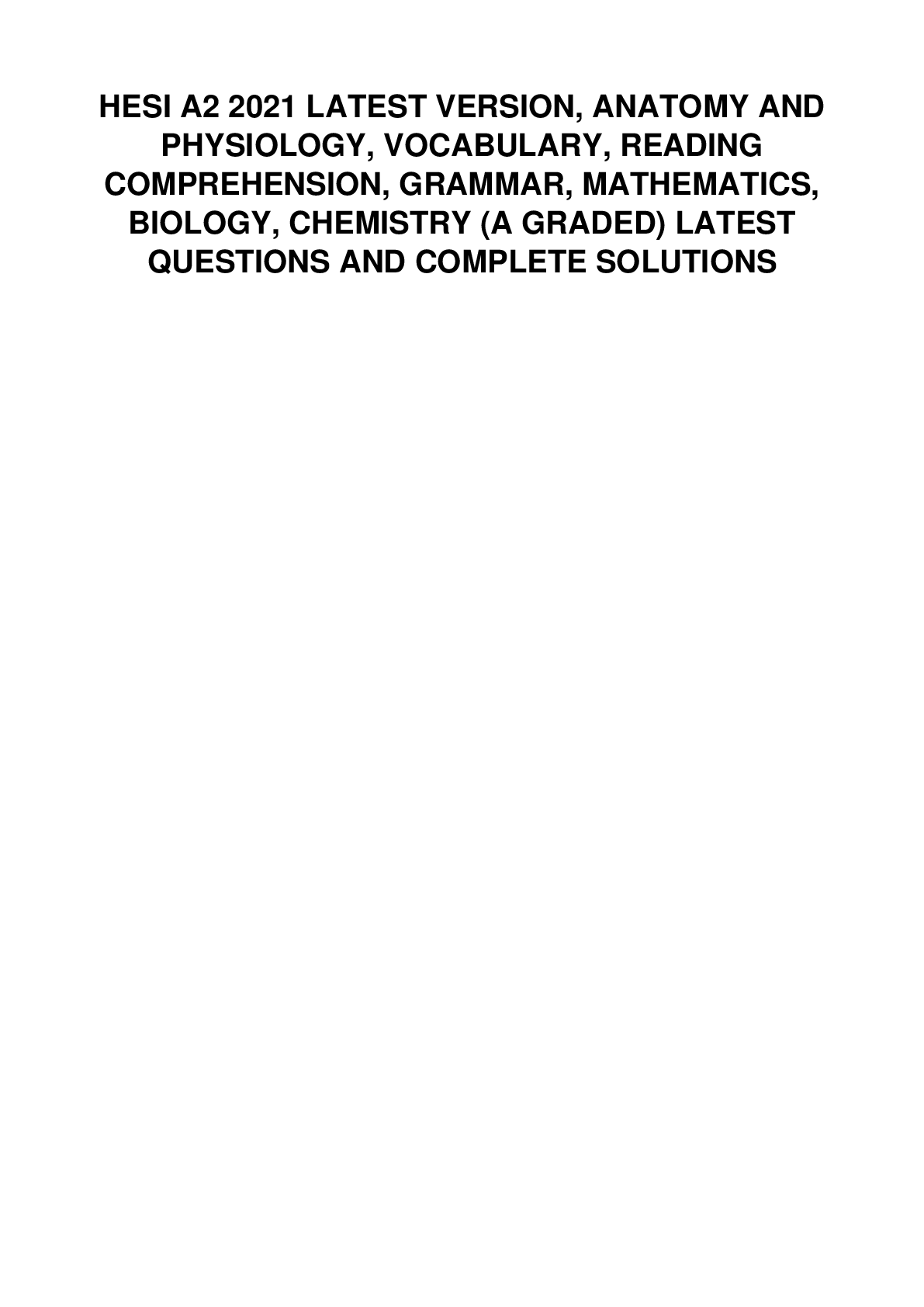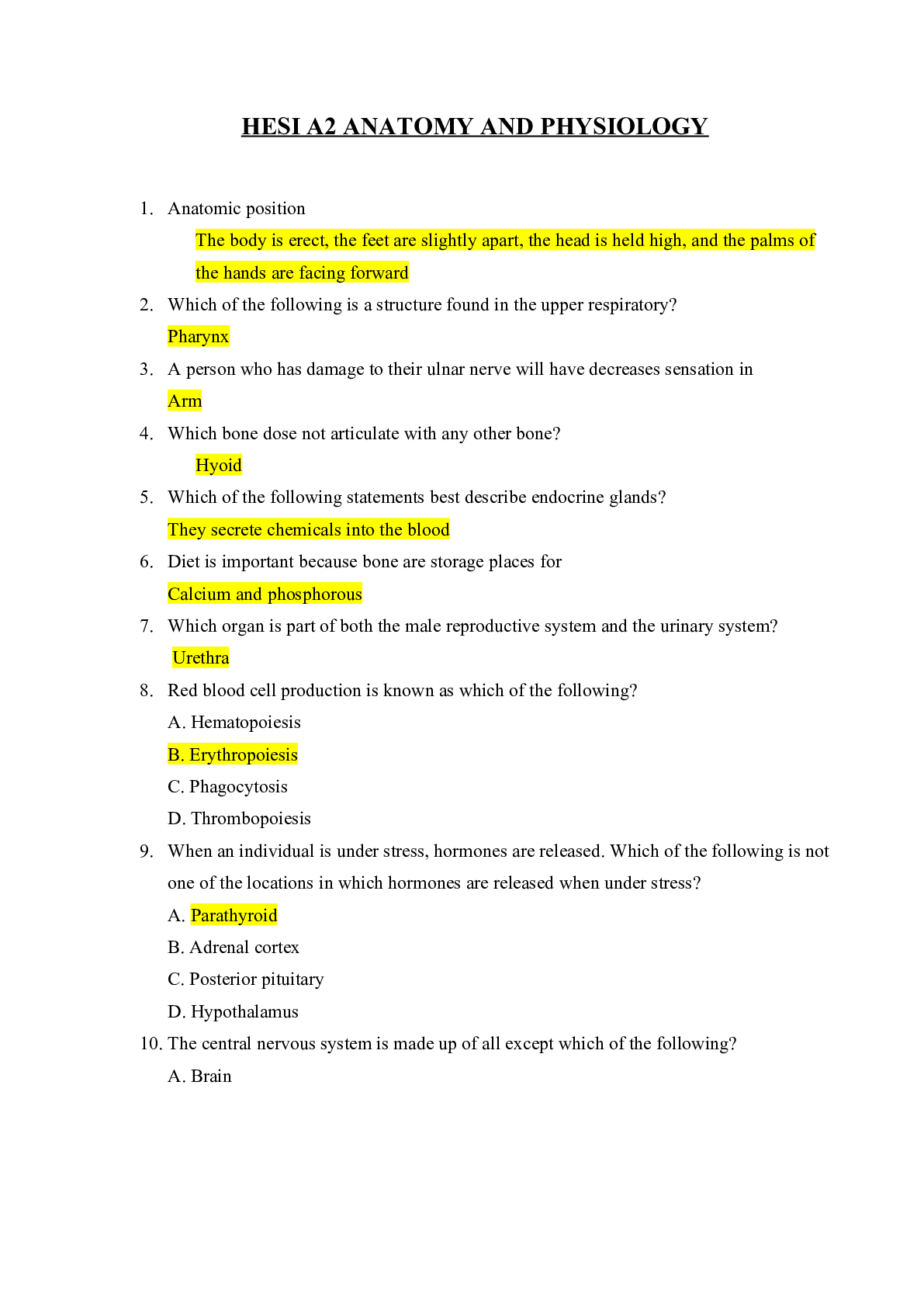HESI A2 Anatomy and Physiology V1 Completed for 2022/2023
Document Content and Description Below
HESI A2 Anatomy and Physiology 1. Anatomic position The body is erect, the feet are slightly apart, the head is held high, and the palms of the hands are facing forward 2. Which of the following i... s a structure found in the upper respiratory? Pharynx 3. A person who has damage to their ulnar nerve will have decreases sensation in Arm 4. Which bone dose not articulate with any other bone? Hyoid 5. Which of the following statements best describe endocrine glands? They secrete chemicals into the blood 6. Diet is important because bone are storage places for Calcium and phosphorous 7. Which organ is part of both the male reproductive system and the urinary system? Urethra 8. Red blood cell production is known as which of the following? A. Hematopoiesis B. Erythropoiesis C. Phagocytosis D. Thrombopoiesis 9. When an individual is under stress, hormones are released. Which of the following is not one of the locations in which hormones are released when under stress? A. Parathyroid B. Adrenal cortex C. Posterior pituitary D. Hypothalamus 10. The central nervous system is made up of all except which of the following? A. Brain B. Heart C. Retina D. Spinal cord 11. The thyrotrophic-releasing growth hormone-releasing, and gonadotropin-releasing hormones are released by which of the following endocrine system glands? A. Thymus B. Pituitary gland C. Pineal gland D. Hypothalamus 12. What is the most visible part of the ear? A. Pinna B. Organ of Corti C. Cochlea D. Ear canal13. Which of the following is an organ of the respiratory system? A. Brain B. Larynx C. Urethra D. Pancreas 14. The motor cortex helps the brain by monitoring and controlling the body's movement. Where is the motor cortex located within the brain? A. Top, middle portion of the parietal lobe. B. Back of the head C. Front portion of the parietal lobe. D. Around the auditory cortex 15. The heart contains four chambers. Which of these four chambers is the largest and the strongest? A. Left ventricle B. Left atrium C. Right ventricle D. Right atrium 16. Which of the following organs is involved with the immune system? A. Heart B. Bronchi C. Appendix D. Esophagus 17. Which of the following is not a principal organ of the nervous system? A. Brian B. Thymus C. Ganglia D. Spinal cord 18. Where do the endocrine system and the nervous system meet? A. At the pituitary gland and the pineal gland B. At the hypothalamus and pituitary gland C. At the pineal gland D. At the thyroid gland 19. The pancreas is an endocrine system gland mainly responsible for which of the following? A. Proper bone development B. Metabolism control C. Maintaining healthy sugar levels D. Distribution of stored fat. 20. The stomach lining membrane name? The mucous membrane of the stomach contains simple columnar epithelium tissue with many exocrine cells. 21. skin aids in maintaining the calcium and phophate levels of the body by participating in the production of which of the following vitamin d22. all action of the nervous system depend on the transmission of nerve impulses over which of the following? neurons 23. which hormone initiates the preparation of the endometrium of the uterus for pregnancy estrogen 24. which female reproductive organ's produce oocytes, estrogen and progesterone ovaries 25. the buttocks is on which surface the body dorsal 26. the esophagus is located at which body cavity thoracic 27. which is a hollow organ gallbladder 28. which muscle is included in the quadriceps femoris group vastus lateralis 29. what occur when the sympathetic nervous system is stimulated? cardiac output 30. which hormone is produce by the posterior pituitary gland oxytocin 31. which structure regulat the transport of substance in and out of a cell the cellular membrane 32. a person who damages to their ulnar nerve will have decrease sesutior in which area arm 33. when assessing a female client who describes herself as a vegetarian in the nurse notes that she has an unusual skin color. The nurse should ask the client if she has eaten large amount of: carrot and squash 34. which structure produces B-lymphocytes Red bone marrow 35. how many days is the avarage menstrul cycle 14 36. where in the human body are nutrients absorbed small intestines 37. The central nervous system is made up of all except which of the following? heart 38. The motor cortex helps the brain by monitoring and controlling the body's movement. Where is the motor cortex located within the brain? top, the middle portion of the parietal lobe. 39. The heart contains four chambers. Which of these four chambers is the largest and the strongest? Left ventricle appendix40. Which of the following is not a principal organ of the nervous system? thymus 41. The pancreas is an endocrine system gland mainly responsible for which of the following? maintain healthy blood sugar level 42. Tough elastic tissues found in the joints that connect bones to bones are called: ligament 43. What mineral is responsible for muscle contractions? calcium 44. Where can the urinary bladder and internal reproductive organs be found? pelvic cavity 45. Nerve tissue is composed of neurons and connective tissue cells that are referred to as which of the following? neuroglia 46. Which tissue serves as the framework of the body by providing support and structure for the organs? connective tissue 47. What are the glands of skin that produce a thin, watery secretion eccrine glands 48. You have been given a sample of tissue that has open spaces partially filled by an assemblage of needle like structures. What is this tissue? spongy bone 49. Which mineral is responsible for regulating fluid in the body? sodium 50. Motor or _____ neurons transmit nerve impulses away from the CNS. efferent 51. What are chemical messengers that control growth, differentiation, and the metabolism of specific target cells called? hormones 52. Which blood vessel where exchanges take place between blood and the cells of the body? capillary 53. The stomach muscle churns and mixes food, turning the mass into a soupy substance called what? chyme 54. All the nutrients that enter the hepatic portal vein are routed where for decontamination? liver 55. In men, spermatozoa develop within the ____ of each testis Seminiferous tubules 56. During pregnancy, what organ produces the hormones that maintain the endometrium and prepare the breasts for milk production? placenta 57. Gland whose secretion is oily- a mixture of oily substances and cell fragmentssabasious 58. Sweat gland whose secretion is s primarily water and salts plus contains protein and fatty subsatances apocrine 59. Smooth muscle structure in the skin arrrector pilli 60. What type of joint is the elbow hinge 61. What type of joint is the hip and shoulder ball and socket 62. what are the two most abundant minerals stored in bones extracellular matrix calcium and phosphate 63. The most abundant glial cells found in the CNS that anchor neurons to capillaries and help control the environment around neurons astrocytes 64. What does the adrenal medulla secrete? Epinephrine and norepinephrine 65. Which skin cancer is the most dangerous? malignant melanoma -becaus it matastisizes(spreads) -Cancer of the melanocytes 66. Which skin cancer is moderatly dangerous? squamous cell carcinom -arises from keratinocytes of stratum spinosum 67. Which skin cancer is least dangerous? basal cell carcinoma -doesnt spread 68. What is the only artery in the body to carry oxygen-poor blood? pulmonary artery 69. Chocolate cysts of the ovaries are attributed to ____. endometriosis 70. tendons connect muscle to bone 71. Where is interstitial fluid found in the body? in the tissues around cells 72. Which lobe of the brain is associated with judgement, planning, impulse control, and social behavior? frontal 73. What does lipase do? It breaks down fats into fatty acids and glycerol. 74. In what area of the body would you expect to find and especially thick stratum corneum? Heel of the foot 75. What two things must be present for a muscle cell to contract?Calcium & adenosine triphosphate (ATP) 76. the esophagus is located at which body cavity a) ventral b) abdominal c) thoracic 77. What is the response of CF cell in the collecting tubules in the nephrons when antiduretic hormone (ADH) is secreted? Water is reabsorbed from the urinary filtration? 78. what is the function of ADH hormone Regulate water balance in the body by controlling the amount of water the kidneys reabsorb 79. which muscle is included in tue quadriceps femoris group a) trapezius b) vastuslateralis c) gastrocnemious d) rectus abdominus 80. the calcaneous is located in whih part of the body the leg 81. Where is the tympanic membrane located? external auditorium canal and tympanic cavity 82. Fats are broken down in the small intestine using which enzyme(s)? Fats also known as lipids are broken down using lipase produced by the pancreas and bile produced by the liver but transferred to the small intestine through the bile duct. 83. What is the only artery to carry oxygen-poor blood? Pulmonic Artery 84. What do ligaments connect? Bone to Bone 85. Is epithelial tissue vascular or avascular? Avascular 86. Which of the following describes the primary function of the respiratory system? A) to create sound and speech B) to take oxygen into the body while removing carbon dioxide C) to transport nutrients to the cells and tissue of the body D) to act as a barrier between the body's organs and outside influences 87. Which of the following is the first step of the scientific method? A) construct a hypothesis B) make observations C) analyze dataD) form a question 88. The process of organisms with an advantageous trait surviving more often and producing more offspring than organisms without the advantageous trait describes which of the following basic mechanisms? A) gene flow B) genetic drift C) mutation D) natural selection 89. Which of the following is the group of basophils that produces follicle-stimulating hormone (FSH) and luteinizing hormone? A) gonadotrophs B) thyotroph C) chromophil D) pituicytes 90. Which of the following are considered the basic units of the female reproductive system, each containing a single immature egg cell that is released during ovulation? A) oocytes B) follicles C) ovaries D) fundus 91. Which of the following describes the muscular organ that processes food material into increasingly smaller pieces, mixes it with saliva to create a bolus, and creates a barrier to transport food into the esophagus? A) pharynx B) tongue C) diaphragm D) stomach92. Which of the following chambers of the heart receives blood returning from the lungs during pulmonary circulation? A) left atrium B) right atrium C) left ventricle D) right ventricle 93. Which of the following is the lobe in the cerebral cortex primarily responsible for processing and integrating sensory information received from the rest of the body? A) frontal lobe B) occipital lobe C) parietal lobe 94. Which of the following is an example of adaptive, or specific, immunity? A) inflammation B) fever C) humoral D) phagocytosis 95. Which of the following describes a situation in which research results are consistent with every subsequent experiment, but the test used in the experiment does not measure what it claims to measure? A) reliable, but not valid B) valid, but not reliable C) neither reliable or valid D) both reliable and valid 96. Which of the following Mendellian laws describes how pairs of alleles within genes separate and recombine separately from other genes? A) law of segregation B) law of dominanceC) law of independent assortment D) law of predictive traits 97. Which of the following describes how atomic radius varies across the periodic table? A) atomic radius increases from top to bottom and left to right on the periodic table B) atomic radius increases from top to bottom and right to left on the periodic table C) atomic radius increases from top to bottom and toward the halogens on the periodic table D) atomic radius increases from top to bottom and toward the noble gases on the periodic table 98. Which of the following is NOT a tissue layer found in skeletal bones? A) periosteum B) bone marrow C) enamel D) cancellous bone 99. Which of the following sets of valves is primarily responsible for preventing blood flow from major blood vessels to the heart? A) atrioventricular valves B) semilunar valves C) tricuspid valves D) bicuspid valves 100. Bone is composed primarily of which of the following inorganic materials? A) calcium B) magnesium C) collagen D) potassium 101. Which of the following is the primary physical barrier the body uses to prevent infection?A) mucus membranes B) stomach acid C) skin D) urine 102. Which of the following is the connective area where nerve impulses send neurotransmitters across a synapse to a muscle cell to stimulate muscle contraction? A) sarcomere B) tendon C) nicotinic receptors D) neuromuscular junctions 103. Which of the following is the region of the brain that controls and regulates autonomic functions such as respiration, digestion, and heart rate? A) cerebellum B) medulla oblongata C) temporal lobe D) cerebral cortex 104. Which of the following describes the primary function of the pyloric sphincter? A) to regulate the movement of digested food material from the stomach to the duodenum B) to neutralize stomach acid C) to prevent food materials and stomach acid from leaking into other bodily tissues D) to begin the process of chemical digestion 105. Which of the following is the location of fertilization in the females? A) uterus B) fallopian tube C) endometriumD) fimbriae 106. The pineal gland is located in which of the following areas in the body? A) below the larynx B) above the kidney C) at the center of the brain hemispheres D) at the base of the brain 107. Which of the following processes aids scientists in observing a population sample in order to answer questions about the whole population? A) univariate analysis B) inferential statistics C) descriptive statistics D) probability 108. Which of the following biological macromolecules is non-soluble, composed of hydrocarbons, and acts as an important source of energy storage for the body? A) carbohydrates B) nucleic acids C) lipids D) proteins 109. Which of the following is specialized tissue in the right atrium that acts as the heart's natural pacemaker by generating the electrical signal for the heartbeat? A) sinus venosus B) sinoatrial node C) atrioventricular node D) septa 110. Which of the following is a dense, interconnected mass of nerve cells located outside the central nervous system?A) ganglion B) dendrite C) cranial nerve D) pons 111. Which of the following is the primary cell found in the tract of the small intestine? A) surface absorptive cells B) surface lining cells C) parietal cells D) hepatocytes 112. Which of the following describes the general function of cytokines in the immune system? A) they communicate between cells to instigate an immune response B) they inhibit blood clotting during inflammation responses C) they bind to specific pathogens to increase pathogen mass D) they transport pathogens trapped in mucus to be destroyed in the stomach 113. Which of the following describes the path through which air moves during inhalation? A) mouth/nose > pharynx > larynx > trachea > bronchi > bronchioles > alveoli B) bronchioles > alveoli > bronchi > larynx > pharynx > lungs C) mouth/nose > bronchi > bronchioles > alveoli > lungs > trachea D) alveoli > bronchioles > lungs > bronchi > trachea > larynx > pharynx > mouth/nose 114. Which of the following is not a function of progesterone in the female reproductive system? A) expression of secondary sexual characteristics, such as enlarged breastsB) stimulation of milk production in the breasts C) regulation and preparation of the endometrial lining of the uterus for potential pregnancy D) inhibition of contractions of the uterus as the ovum is released 115. Which of the following layers of skin acts as an energy reserve by storing adipocytes and releasing them into circulation when energy is needed? A) epidermis B) dermis C) hypodermis D) stratum basale 116. Neurotransmitters send chemical messages across the gap between one neuron and another in which of the following structures? A) cell membrane B) ganglion C) synapse D) axon 117. Hund's rule states which of the following? A) chemical bonds are formed only between electrons with similar spin B) the attraction between electrons holds atoms together C) a ground state atom always has a completely filled valence shell D) electrons fill orbitals singly and with similar spin before pairing 34) Which of the following is the primary function of the large intestine? A) absorbing digested material into the blood B) nutrient processing and metabolizingC) absorbing water and compacting material into solid waste D) bile production and storage 35) When setting up the above experiment, the scientist has the option of using a separate water filter for each of the three tanks or using a single filtration system that attaches all three and affects them simultaneously. Which of the following filter set ups makes a more valid experiment and why? A) separate filters for each of the three tanks, because this ensures a higher quality of water for each tank B) one filtration system for all three tanks, because this makes filtration a controlled variable C) one filtration system for all three tanks, because this reduces the workload for the researcher D) separate filters for each of the three tanks, because this adds another variable to be tested and analyzed for inclusion in the experiment's results 36) The above experimental design description is an example of which of the following types of experiments? A) field experiment B) natural experiment C) controlled experiment D) observational study 37) Which of the following is the control group in the above experiment A) tank A B) tank B C) tank C D) there is no control group in this experiment 38) Which of the following is a type of white blood cell that plays a key role in adaptive immunity by seeking out, attacking, and destroying targeted pathogens? A) B cells B) goblet cellsC) antibodies D) T cells 39) Which of the following are the blood vessels that transport blood to the heart? A) arteries B) capillaries C) venules D) veins 40) Which of the following organelles are the site of lipid synthesis? A) smooth endoplasmic reticulum B) ribosome C) rough endoplasmic reticulum D) golgi apparatus 41) Which of the following describes a series of measurements that produces exact results on a consistent basis? A) accurate B) precise C) valid D) significant 42) Chromatids divide into identical chromosomes and migrate to opposite ends of the cell in which of the following phases of mitosis? A) metaphase B) anaphase C) prophase D) telophase43) A series of muscle contractions that transports food down the digestive tract in a wave-like fashion describes which of the following? A) digestion B) deglutition C) defecation D) peristalsis 44) Which of the following is NOT a function of the liver? A) nutrient processing B) blood filtration and detoxification C) cholesterol and lipoprotein production D) insulin production and blood sugar regulation 45) 2C6H14 + 19O2 --> 12CO2 + 14H2O. The reaction above is an example of which of the following? A) substitution reaction B) acid-base reaction C) enzyme reaction D) combustion reaction 46) Which of the following are regions of the digestive system in which amylase is produced? A) pancreas and salivary glands B) gall bladder and salivary glands C) gall bladder and liver D) pancreas and liver 47) Which of the following describes a cell's reaction to being placed in a hypertonic solution? A) the cell will shrink as water is pulled out of the cell to equalize the concentrations inside and outside the cellB) the cell will swell as water is pulled into the cell to equalize the concentrations inside and outside the cell C) the cell will remain the same size since the concentrations inside and outside the cell are equal to begin with D) the pH inside the cell will drop in order to equalize the pH inside and outside the cell 48) Which of the following are the two major zones of the respiratory system? A) left bronchus and right bronchus B) nose and mouth C) larynx and pharynx D) conducting and respiratory 49) Which of the following is not one of the major tissue layers of the alimentary canal? A) submucosa B) muscularis C) adventitia D) duodenum 50) Which of the following distinguishes the isotopes of an element? A) isotopes are atoms of the same element that have different ionic charges B) isotopes are atoms of elements within the same group on the periodic table C) isotopes are atoms of the same element that have different numbers of neutrons D) isotopes are atoms of the same element with different electron configurations 51) Which of the following is the cartilaginous flap that protects the larynx from water or food while still allowing the flow of air? A) epiglottis B) bronchioles C) epitheliumD) tongue 52) Which of the following describes the function of the fascia in muscle tissue? A) to enclose, protect, support, and separate muscle tissue B) to connect muscle tissue to bone C) to serve as the contractile until of muscle D) to slide past the actin protein cells in muscle to create contraction 53) Which of the following correctly describes a strong acid? A) a strong acid completely ionizes in water B) a strong acid donates more than one proton C) a strong acid contains at least one metal ion D) a strong acid will not decompose 54) The process by which blood circulates oxygen from the lungs to the body's tissues is an example of which of the following? A) external respiration B) internal respiration C) inhalation D) exhalation 55) Which of the following is the material that is secreted into hair follicles to waterproof and lubricate the skin? A) sweat B) sebum C) vernix caseosa D) mucus 56) Which of the following are the connective tissues that attach bone to bone and help strengthen joints?A) tendons B) cartilage C) collagen D) ligaments 57) Which of the following is NOT a nucleobase of DNA? A) adenine B) guanine C) thymine D) uracil 58) Which of the following materials is the primary structural protein of the epidermis, nails, and skin? A) eponychium B) collagen C) keratin D) fibroblast 59) Which of the following correctly describes atomic number? A) the atomic number is the number of atoms in a mole of a given substance B) the atomic number is the number of neutrons in an atom C) the atomic number is the number of atoms in a gram of a given substance D) the atomic number is the number of protons in an atom 60) Which of the following is a descriptive, generalized body of scientific observations? A) law B) theory C) modelD) hypothesis 61) Which of the following types of cells are the main transporters of oxygen through the body? A) goblet cells B) white blood cells C) red blood cells D) platelets 62) Which of the following is the general term for a chemical substance that the body produces and transports through the blood to stimulate a cellular response? A) hypophysis B) amino acids C) oxytocin D) hormones 63) Which of the following is NOT a function of hair? A) regulation of body temperature B) extension of the sensory system C) protection from UV radiation D) protecting soft tissue from injury 64) Which of the following is NOT one of the functions of proteins found in the phospholipid bilayer of a cell membrane? A) to break down material that enters through the cell membrane B) to act as receptors that recognize and transmit hormonal messages C) to provide an attachment point for other cells D) to transport material across the membrane into the cell 65) Which of the following is the muscular action that moves a part of the body away from its median plane?A) abduction B) adduction C) pronation D) supination 66) Which of the following does NOT distinguish quantitative data collection from qualitative data collection methods? A) qualitative methods are more open-ended than quantitative B) results from randomized quantitative methods can be applied to a general population; results from qualitative cannot C) quantitative methods are number based; qualitative methods are text based D) qualitative methods do not need to be as valid or reliable as quantitative methods 67) Which of the following is an example of a birthmark caused by an increased volume of capillaries close to the surface of the skin? A) ephelides B) vascular nevis C) melanocytes D) comedones 68) Which of the following correctly describes the valence shell of an atom? A) the valence shell is the outermost-occupied electron orbital energy level B) the valence shell is always partially filled with electrons C) the valence shell is found only in ions, not in neutral atoms D) the valence shell must contain p-orbitals 69) Which of the following describes how skeletal muscles and bones work together to stimulate movement? A) muscles contract and exert force on the bone, which acts as a lever to stimulate movementB) bones contract and exert force on the muscle, which acts as a lever to stimulate movement C) muscles elongate, moving the bone involuntarily D) bones elongate, moving the muscle involuntarily 70) Which of the following describes the correct order of stages of the cell cycle? A) interphase --> mitosis --> cytokinesis B) prophase --> metaphase --> anaphase --> telophase C) interphase --> meiosis I --> meiosis II D) gap I --> synthesis --> gap II 71) Which of the following occurs due to a hypersensitivity in the immune system that causes a major inflammatory response to a common material? A) development of antibodies B) autoimmune disorders C) allergies D) AIDS 72) Which of the following is one of the primary muscles that drives ventilation? A) thoracic cavity B) oblique C) lungs D) diaphragm 73) White blood cells develop from stem cells located in which of the following organs? A) thymus B) bone marrow C) lymph nodeD) spleen 75) Which of the following molecules have London dispersion forces? A) all atoms and molecules have London dispersion forces B) atoms and molecules with full valence shells have London dispersion forces C) atoms and molecules with a noble gas electron configuration have London dispersion forces D) atoms and molecules that contain at least one metal atom have London dispersion forces 76) Which of the following are the two proteins found in muscle tissue that cause muscle contraction as they slide past one another? A) actin and sarcomeres B) actin and myosin C) myosin and tropomyosin D) troponin and sarcomeres 77) Which of the following is NOT a hormone-producing gland of the endocrine system? A) steroid B) pituitary C) adrenal D) thyroid 78) Which of the following is the process in which pathogens are "eaten", or absorbed and digested, by white blood cells as part of an immune response? A) pinocytosis B) phagocytosis C) opsonization D) vasodilation 79) Which of the following describes the relationship between correlation and causation?A) correlation implies causation B) only negative correlation implies causation C) correlation and causation are mutually exclusive; if one happens, the other cannot D) correlation does not imply causation 80) The exchange of gases and blood happens in which of the following parts of the respiratory zone? A) alveoli B) alveolar duct C) pleura D) bronchioles 81) Which of the following glands provides nourishment for sperm, as well as the majority of the fluid that combines with sperm to form semen? A) seminal vesicles B) prostate gland C) bulbourethral glands D) Cowper's glands 82) Which of the following is the largest branch of the abdominal aorta, which supplies oxygenated blood to the upper digestive tract? A) inferior mesenteric artery B) gastric artery C) celiac artery D) superior mesenteric artery 83) Which of the following is NOT a phase of spermatogenesis, or the final stage of sperm formation? A) tail formation B) cap phaseC) golgi phase D) fertilization 84) Blood is metabolized in the liver as it passes through which of the following types of blood vessels? A) hepatic vein B) inferior vena cava C) arterioles D) sinusoidal capillaries 85) Which of the following is a heterogenous mixture? A) a mixture in which the atoms or molecules are distributed unevenly B) a mixture of more than one type of atom or molecule C) a mixture of covalent and ionic compounds D) a mixture of polar and nonpolar molecules 86) Hormones can be classified into one of four basic groups based on their chemical source. Which of the following groups is derived from cholesterol? A) catecholamines B) steroids C) polypeptides D) eicosanoids 87) Which of the following is a definition of adaptation, in the context of evolution? A) the process of descent with modification B) the increased likelihood that a particular genotype will increase in frequency in a population C) the process of individuals in a population choosing mates due to superior characteristics D) a biological feature or behavior in a population of organisms that improves its chances for survival in the environment88) Which of the following is the element of blood that comprises most of its volume? A) plasma B) red blood cells C) white blood cells D) water 89) Which of the following is NOT true for enzyme-catalyzed reactions? A) the reaction will speed up if the concentration of substrate increases B) the reaction will speed up if the concentration of enzymes increases C) the reaction will slow down at very low temperatures D) the reaction will speed up without limit as the temperature increases 90) Which of the following is the molecule found in red blood cells that binds to up to four oxygen molecules? A) hemoglobin B) erythrocytes C) globulin D) antigens 91) Which of the following is NOT a reason why randomization is critical in experimental design, especially in experiments with human subjects? A) to give humans no choice but to participate B) to eliminate selection bias C) to provide a statistical basis D) to provide a balanced group of subjects 92) Which of the following is the division of the nervous system primarily responsible for regulating all involuntary and subconscious muscle functions? A) somatic nervous systemB) autonomic nervous system C) sympathetic nervous system D) peripheral nervous system 93) Which of the following is an appendage of a neuron that sends electrical signals away from the neuron cell? A) axon B) dendrite C) neurite D) neuroglia 94) Which of the following is the definition of action potential in a neuron? A) a connection between two neurons B) an electrical impulse that is transported down a neuron in response to a stimulus C) an imbalanced electrical charge that exists in an inactive nerve cell D) a chemical signal between two nerve cells 95) Which of the following are the three major portions of the brain? A) cerebellum, spinal cord, white matter B) cerebrum, temporal lobe, occipital lobe C) pons, medulla oblongata, brain stem D) cerebrum, cerebellum, brain stem 96) Which of the following describes how a catalyst speeds up a reaction? A) a catalyst participates in the reaction, making it go faster B) a catalyst speeds up a reaction by causing lower energy products to be made C) a catalyst lowers the activation energy by providing an alternate route for the reactionD) a catalyst causes the reactants to collide more frequently 97) Which of the following is the final vessel through which semen must pass before being expelled from the body? A) ejaculatory duct B) penile urethra C) membranous urethra D) vas deferens 98) Which of the following groups of bones are part of the axial skeleton? A) pectoral girdle B) rib cage C) arms and hands D) pelvic girdle 99) Which of the following types of variables is changed in a scientific experiment? A) controlled variable B) measured variable C) dependent variable D) independent variable 100) The vertebral column consists of thirty-three vertebrae and is divided into several groups. Which of the following describes the lumbar vertebrae? A) seven vertebrae located in the neck that connect the vertebral column to the skull, allowing for neck rotation B) five vertebrae that are fused in the pelvis, forming a supportive, wedge-shaped bone C) twelve vertebrae located in the upper back, each of which connects to the base of a rib D) five vertebrae located in the lower back, which support most of the body's weight 101) Which type of hypothesis assumes no relationship between two variables?A) scientific hypothesis B) working hypothesis C) null hypothesis D) alternate hypothesis 102) Which of the following describes the applicability of a research conclusion to situations outside the experiment? A) internal validity B) test validity C) external validity D) content validity 103) Which of the following is NOT one of the three types of muscles found in the human body? A) skeletal B) cardiac C) soft D) smooth 1. Ligaments provides with connection? Bone to bone 2. What structure conduct urine from the kidney to the urinary bladder? Ureter 3. Anaerobic respiration can lead to a burning sensation caused by with molecule? Lactic acid 4. As part of the negative feedback system, which type of cell is stimulated to resorb bone matrix in response to a decrease in calcium in the blood? Osteoclasts 5. Sweat on the skin's surface cools the body through which process? Evaporation 6. When assessing a female client who describes herself as a vegetarian in the nurse notes that she has an unusual skin color. The nurse should ask the client if she has eaten large amount of: carrot and squash.7. Which hand position describes an anatomical position of a person who is standing erect with feet forward? Palms of the hand facing anterior 8. Which structure is a ball and socket joint? Shoulder 9. Which anatomical structure houses the malleus, incus, and stapes? Skull ear 10. What are like cells grouped together called? A tissue 11. The pulse point located behind the knee is palpated over which artery? Popliteal 12. Ceruminous glands secrete Ear wax 13. What type of synovial joint is the elbow? Hinge 14. What occurs when the sympathetic nervous system is stimulated? Increased Cardiac output 15. Where does digestion begin in the digestive system? Oral cavity 16. Which structure regulates the transport of substances in and out of a cell? The cell membrane 17. The mediastinum is located within which cavity? Thoracic 18. What is the effect of serotonin, a neurotransmitter? Involved with mood, anxiety and sleep 19. What is the response of cells in the collecting tubules in the nephrons when antidiuretic hormone AHD is secreted? . Water is reabsorbed from the urinary filtrate 20. What is the function of the thrombocytes (platelets)? . Play role in blood clotting 21. Which muscle of the quadriceps femoris group lies on the slide surface of the lower extremity? Vastus lateralis 22. Which structure is located on the sternum Xiphoid process 23. The occipital region is located in which part of the body? Head 24. Which structure carries oxygen to the cells? Hemoglobin 25. Which gland is commonly known as the "Master Gland"? Pituitary Gland 26. Aspirin occurs when there is a tear in which structures? Ligament 27. What epidermal derivative is involved in temperature homeostasis?Eccrine gland 28. Which statement are true about bone? Osteoblast,epiphyseal, diaphysis 29. Aqueous humor is watery fluid in which part of the body? Eye 30. The Malleus, Incus, and Stapes are located in which part of the body? Ear 31. Dorsiflexion plantar flexion are types of joint movement that are associated with which part of the body? Foot 32. Within which vessel does blood return from the lungs? Pulmonary vein 33. Which part of the brain is involved in auditory functioning? Temporal lobe 34. What internal structure of the ear is concerned with hearing? Cochlea 35. Fertilization of an ovum occurs in which anatomical structure? Fallopian tubes 36. Where is the tubialis anterior muscle located? Lower leg 37. An over-production of cerumen (earwax) can accumulate in which area? External ear canals 38. The mitral value is located between which two structures? Left ventricle & Left atrium 39. The olfactory nerves is associate in which sense? Smell 40. Vessel carries blood from the body to the heart? Vena cava 41. Hormone(s) is/are produced by the ovaries? Estrogen & progesterone 42. Plane divides the body into right and left sides? Sagittal 43. Two principles divisions that makeup nervous system? Peripheral (PNS) & Central (CNS) 44. The orthopedic surgeon informs you that you have broken the distal region of the humerus. What area is he describing? Epiphysis 45. Part of the brain attaches to spinal cord? Medulla oblongata 46. Which term is used to describe movement of the arms and legs away from midline of the body? Abduction 47. Structure provides a pulse reading in the neck? Carotid Artery48. Which hormone is produce by the posterior pituitary gland? Oxytocin 49. What is the primary function of the hemoglobin (blood)? Carry oxygen 50. What stimulates the chemoreceptors to function? rise in CO2; Fall in o2 or Rise in cardon dioxide; Fall in oxygen. 51. Which condition causes a client to say "I can't see far away"? Nearsightedness 52. Anaerobic respiration can lead to burning sensation caused by which molecule? lactic acid 53. What organ produces insulin? pancreas 54. What effects do serotonin has or neurotransmitters? appetite, sleep, mood 55. Fertilization occurs in the? oviduct 56. When drawing blood from autecubital region which blood vessel is used to obtain blood? median cubital 57. What hormone induces growth of pubic and axillary hair at puberty? Testosterone and estrogen 58. Increase in rate of depth of breath results in what blood PH change? alkalosis 59. What lobe of the brain is responsible for auditory functioning? Temporal 60. What is the function of the hypothalamus regulates function of body, balance, thermoreg 61. When water molecules move across cell membrane from high to low concentration this process is called? Osmosis 62. What plane divides the body from left to right? sagittal plane 63. What part of the body is the lower back? lumbar 64. High levels of which ion would most likely result in a cardiac arrest? Potassium 65. What blood vessel prefuses the kidney? Renal vein 66. What glad is located on the anterior surface of the trachea? Thyroid Gland 67. In white blood cells what contributes to phagocytosis? macrophages, neutrophils 68. What part of the brain is attached to the spinal cord?medulla oblongata 69. What structure of the eye picks out color? retina 70. What is the outer most protective layer of the skin? Epidermis 71. The organ of corti is located in? Ear 72. Where in the body are nutrients absorbed? Small intestine 73. What cell structure regulates the transportation of substances in and out the cell? Plasma membrane 74. The rough endoplasmic reticulum functions in the human cell to? Synthesize protein 75. What is the response of cells in the collecting tubules in the nephrons when antidiuretic hormone ADH is secreted? water is reabsorbed from urinary filtrate 76. Tissue repair is enhanced by a diet high in? Protein 77. What is the definition of chyme? bolus that turns into soupy substance. 78. What are hormones? chemical messengers 79. What female reproductive organ produces oocytes, estrogen, progesterone ovaries 80. What structure is located in the upper airways? nose, pharynx 81. Which is a hollow organ? gall bladder 82. Which muscle is included in the quadriceps femoris group? Rectus femoris, Vastus lateralis, vastus medilis, vastus intermedius 83. Which structure is responsible for normal respiratory function? medulla oblongata 84. The Mitral valve is located between which two structures? left atrium left ventricle 85. Which hormone is produced by the posterior pituitary gland? ADH and OT 86. Client has large pituitary tumor what part of the body does this effect? head hurt, sickness, low blood pressure 87. Which structure produces B-lymphocytes? red bone marrow 88. What occurs when the sympathetic nervous system is stimulation is increased? Blood pressure rises, goose bumps 89. The buttocks are which surface of the body?dorsal 90. The esophagus is located in which body cavity? thoracic 91. The tympanic membrane is located between which structures? external auditory canal and middle ear 92. How many days is the average menstrual cycle? 28 days 93. Which structure produces T-lymphocytes? thymas 94. A person who has damaged the ulnar nerve will have decreased sensation in which area? arm -inability to adduct arms and fingers 95. Calcaneus is located in? foot 96. Urinary system in the human body primary task is to? expel waste 97. Which of the following produce progesterone to prepare the uterus for pregnancy? Corpus luteum 98. what are fingerprints made of Friction Ridges 99. ABCD of cancer? Melanoma 100. which of the following location would the urinary bladder & internal reproductive organ be found pelvic region 101. which one increases angle at the joint extensor 102. which hormone is release by posterior lobe oxytocin. 103. order of organization of living things organelle, cells, tissues, organs, organ systems, organisms, populations, communities, ecosystem, and biosphere. 104. Which is a hollow organ? gall bladder [Show More]
Last updated: 1 year ago
Preview 1 out of 35 pages
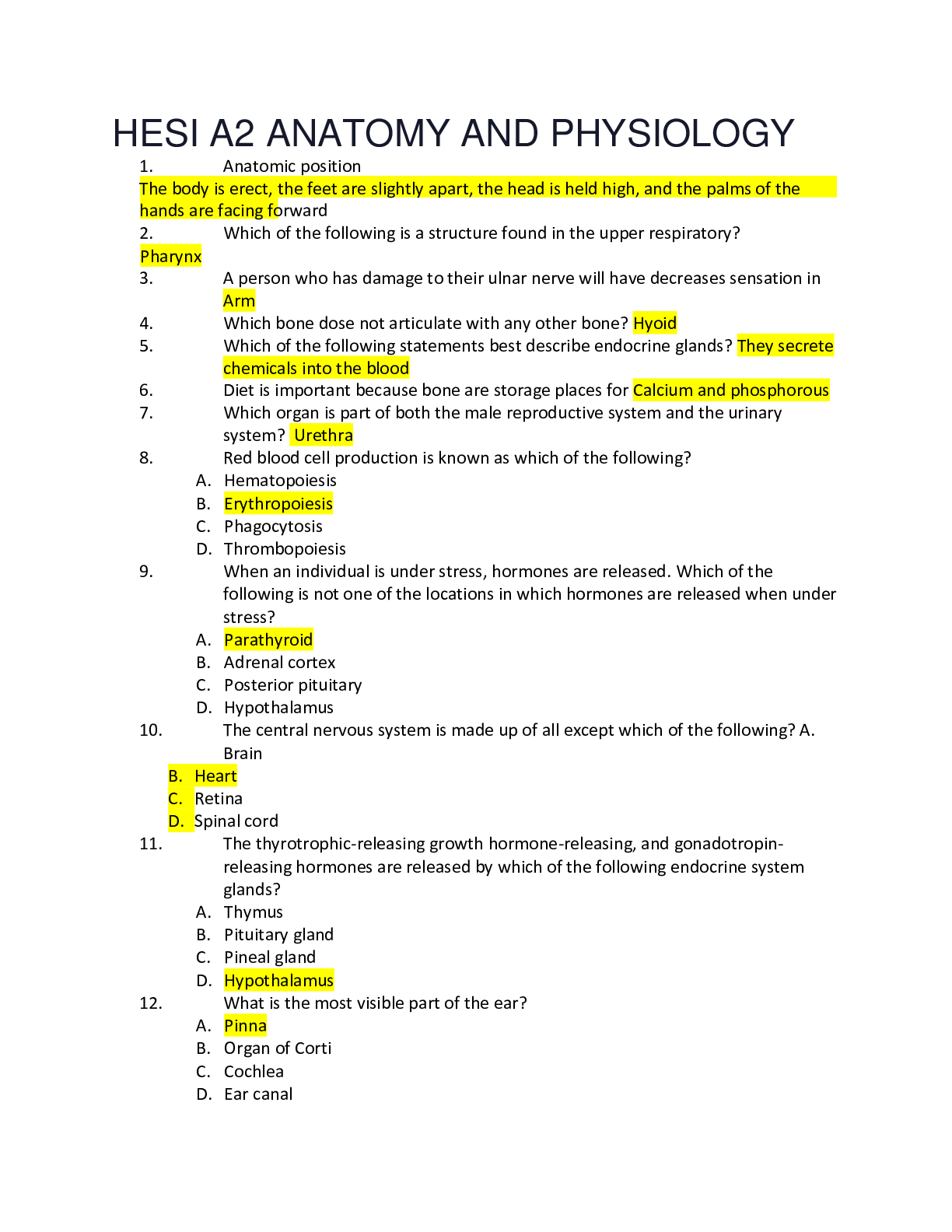
Reviews( 0 )
Document information
Connected school, study & course
About the document
Uploaded On
Jan 27, 2021
Number of pages
35
Written in
Additional information
This document has been written for:
Uploaded
Jan 27, 2021
Downloads
0
Views
95
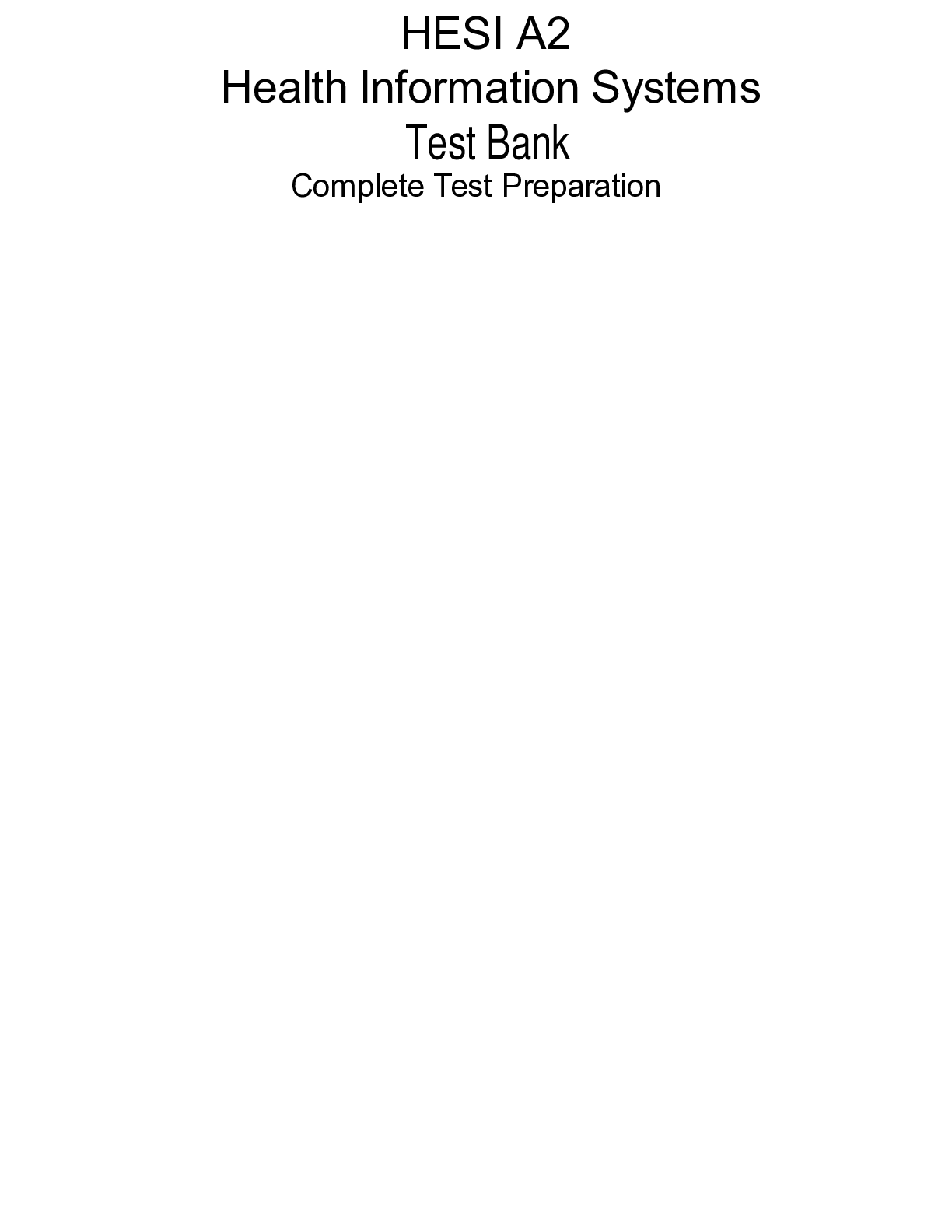


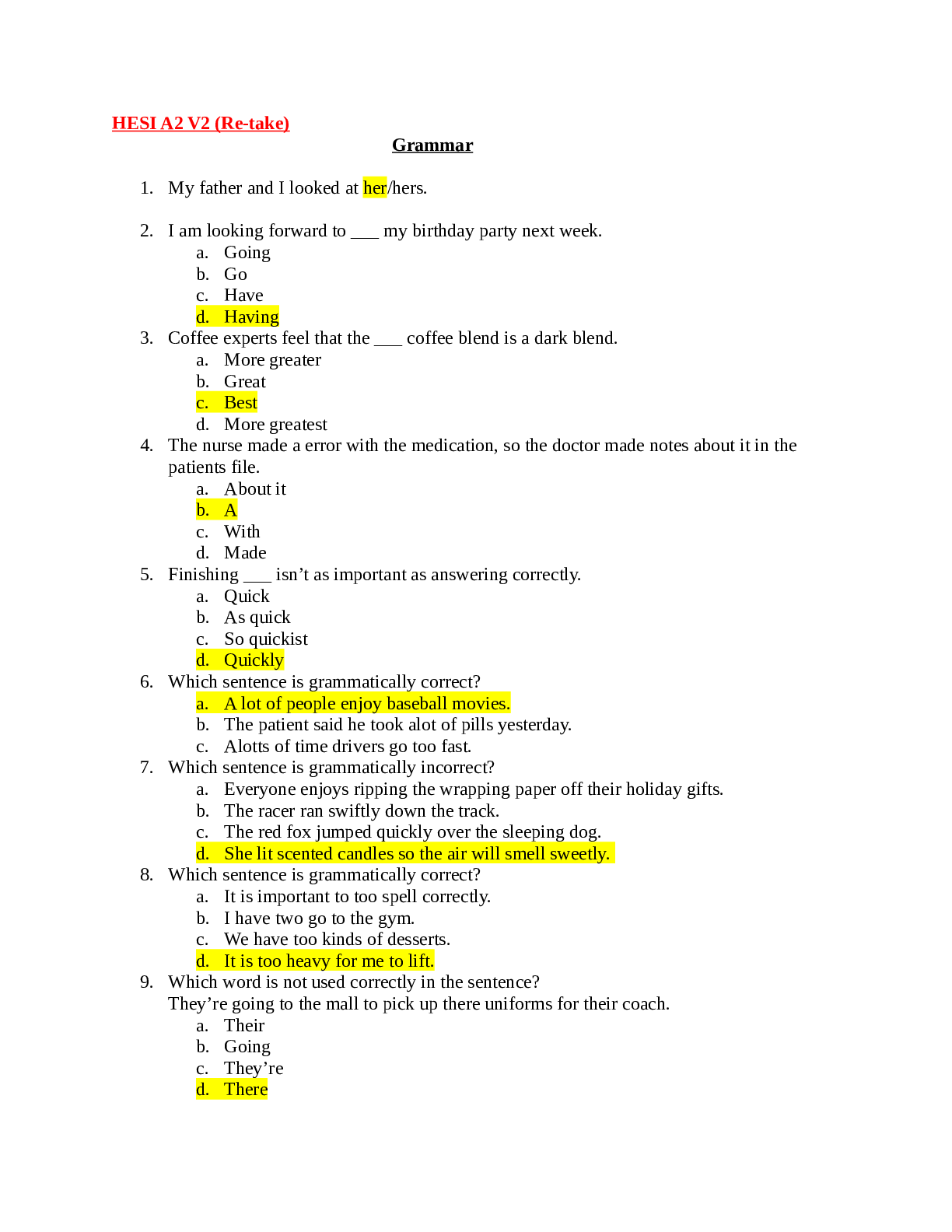

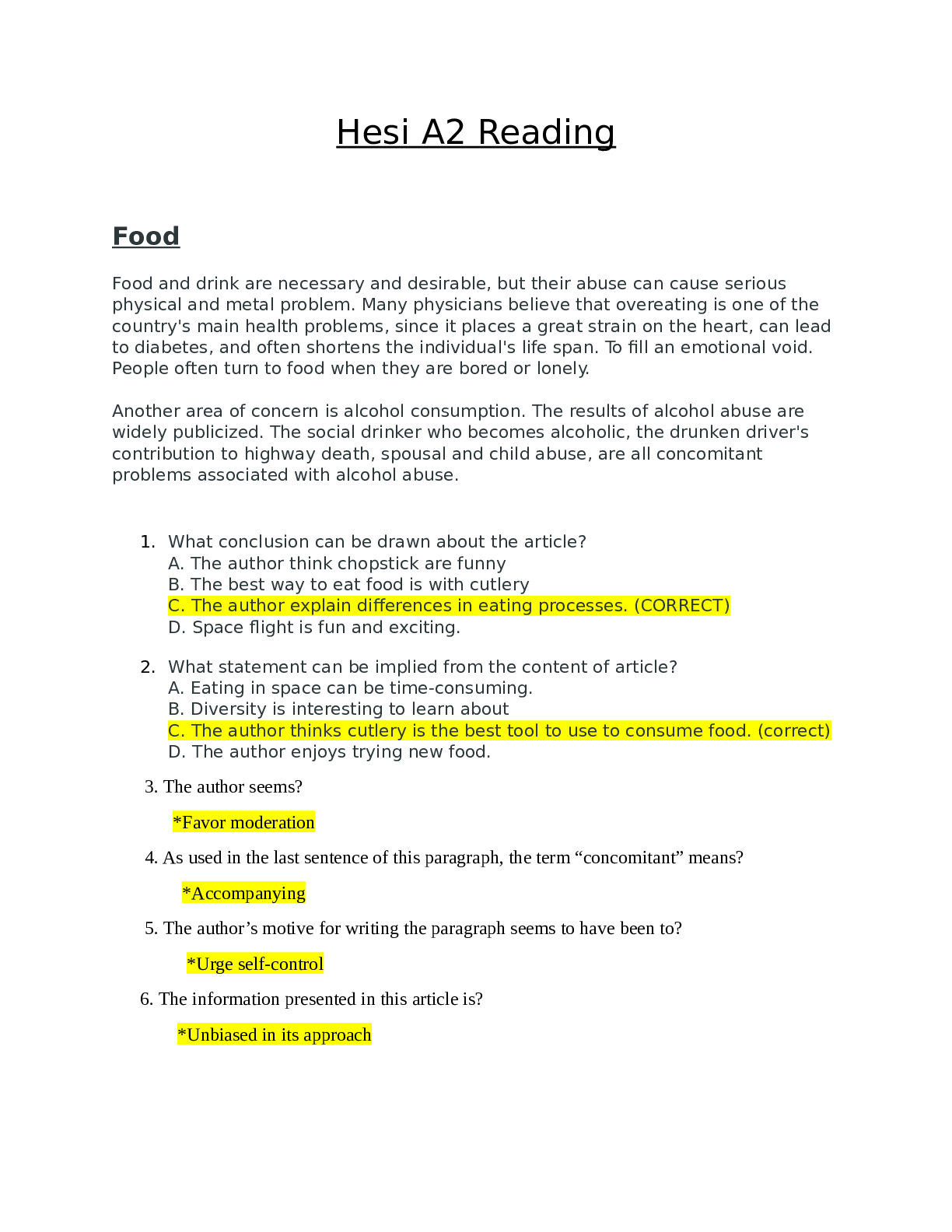
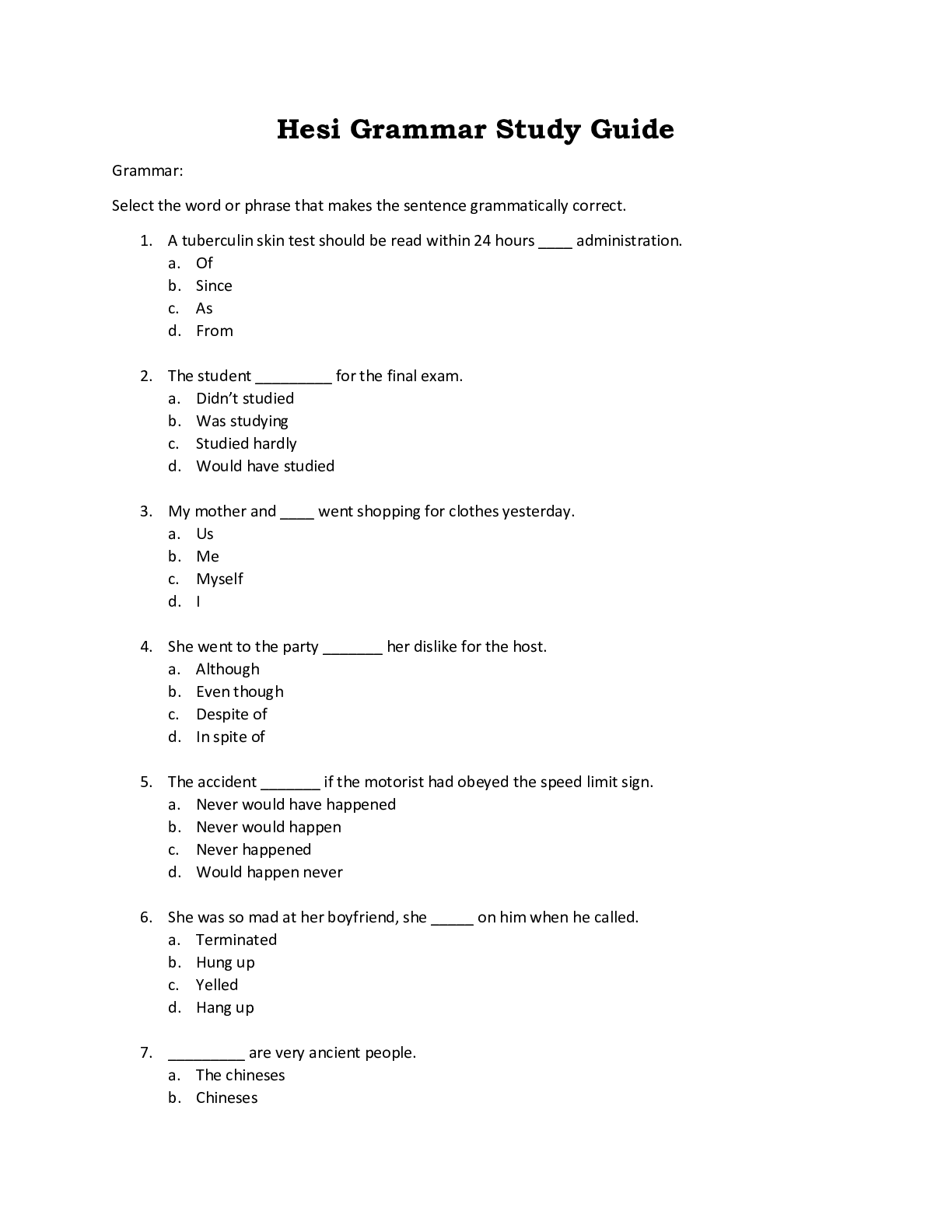

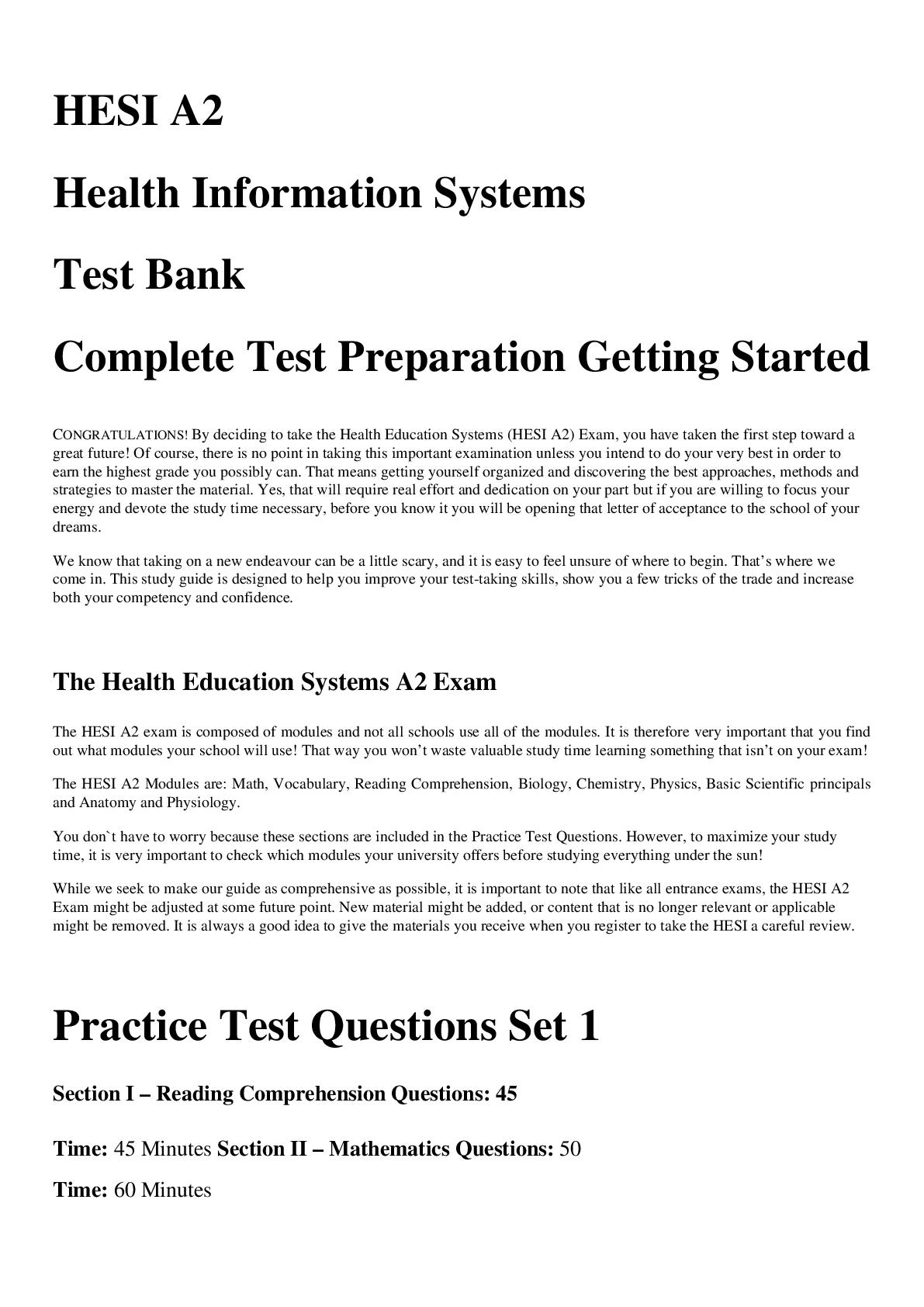
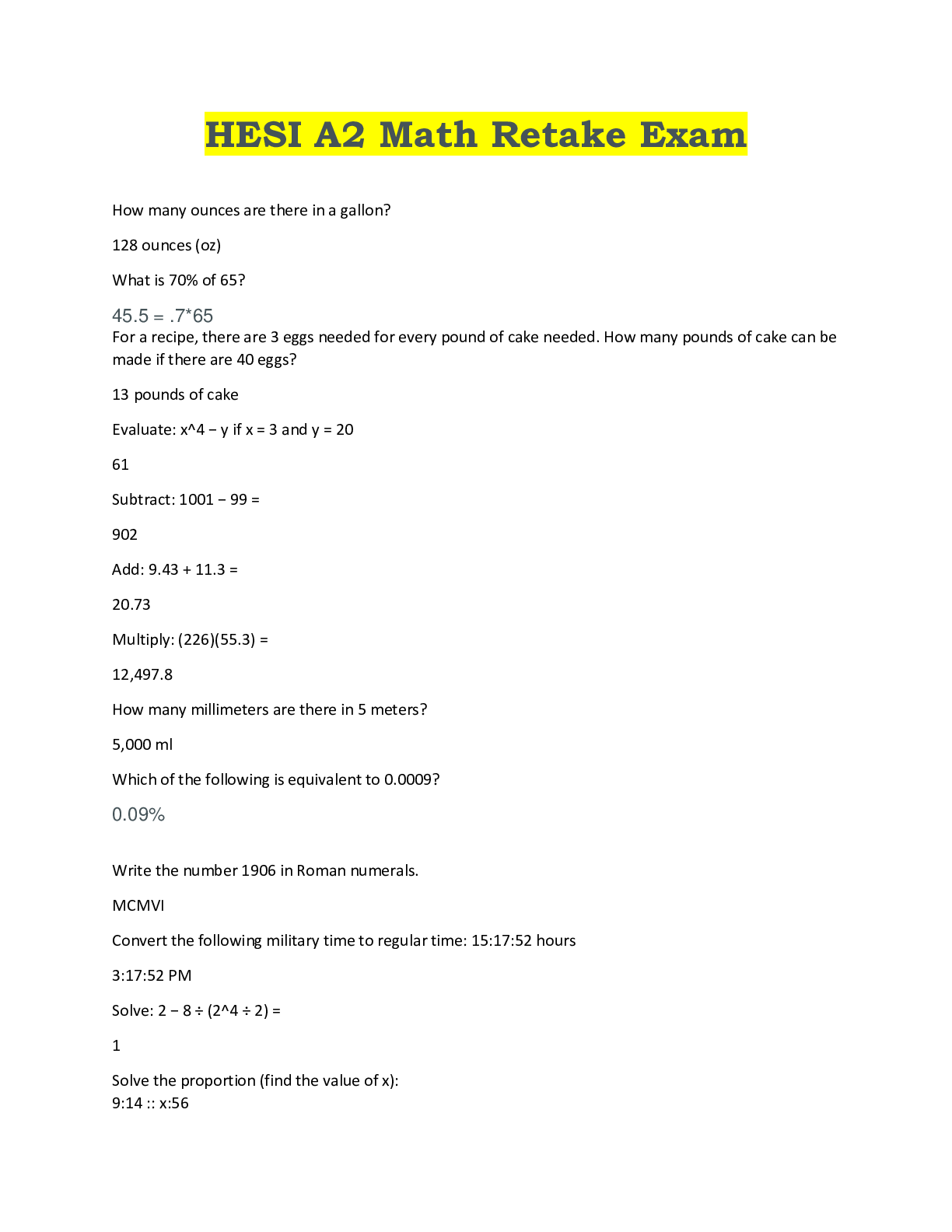
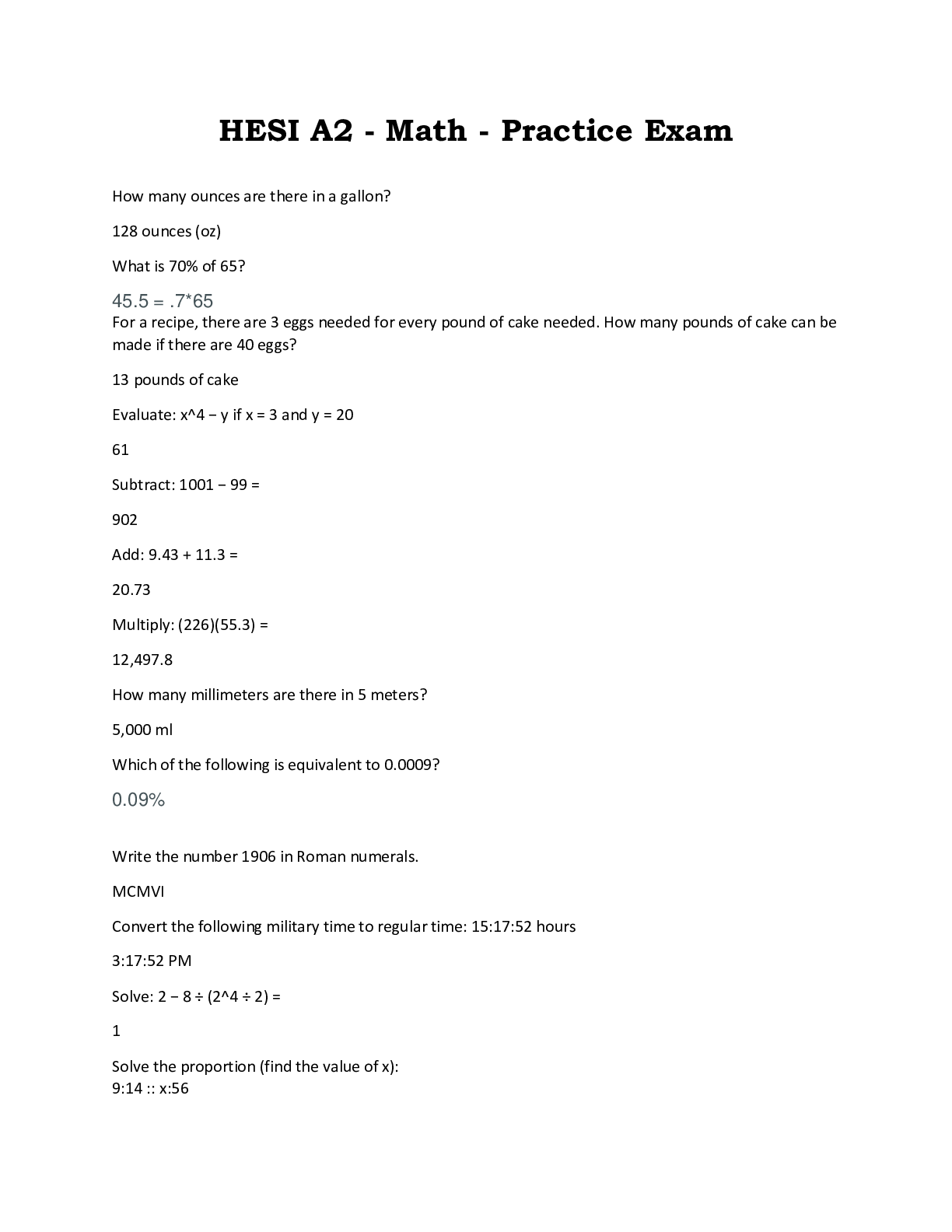
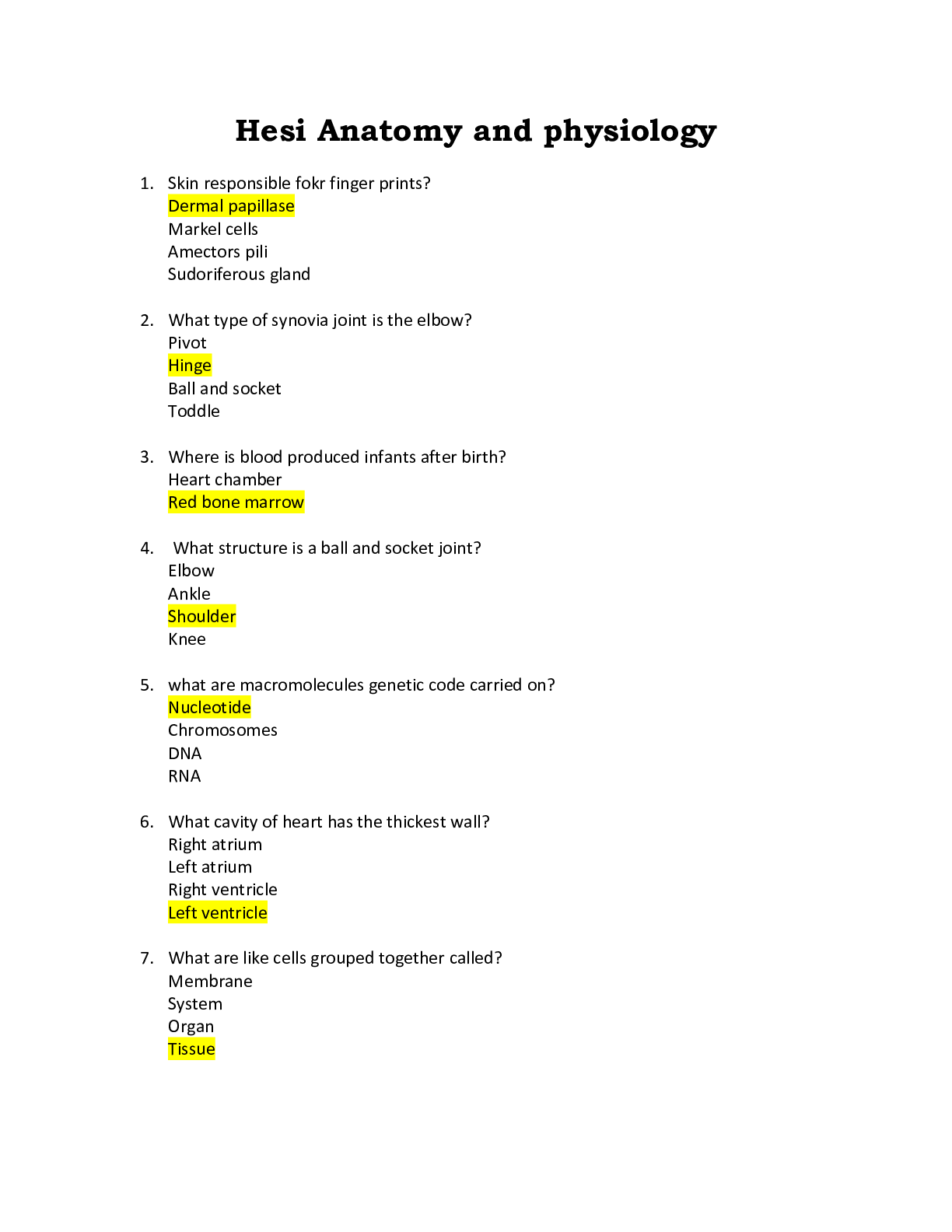
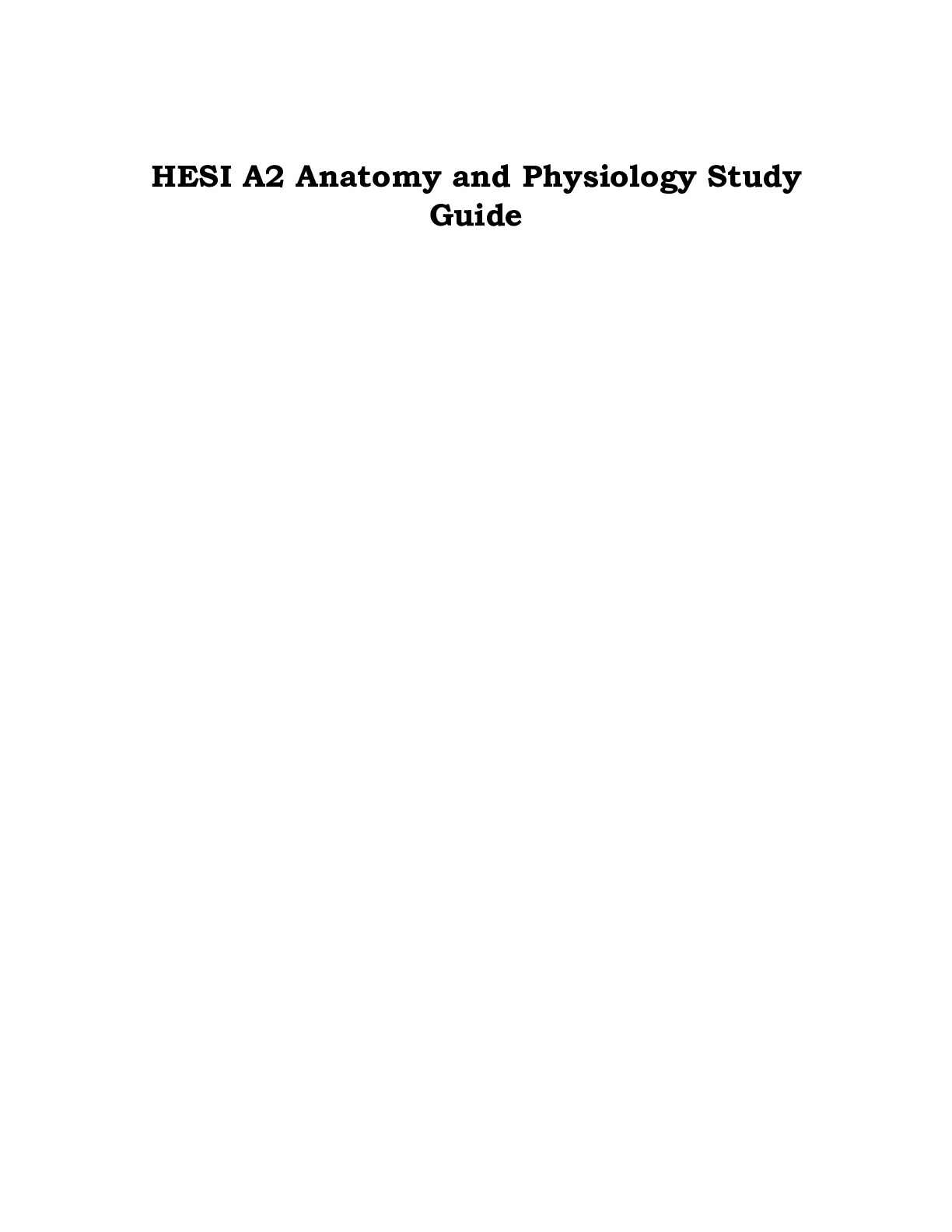
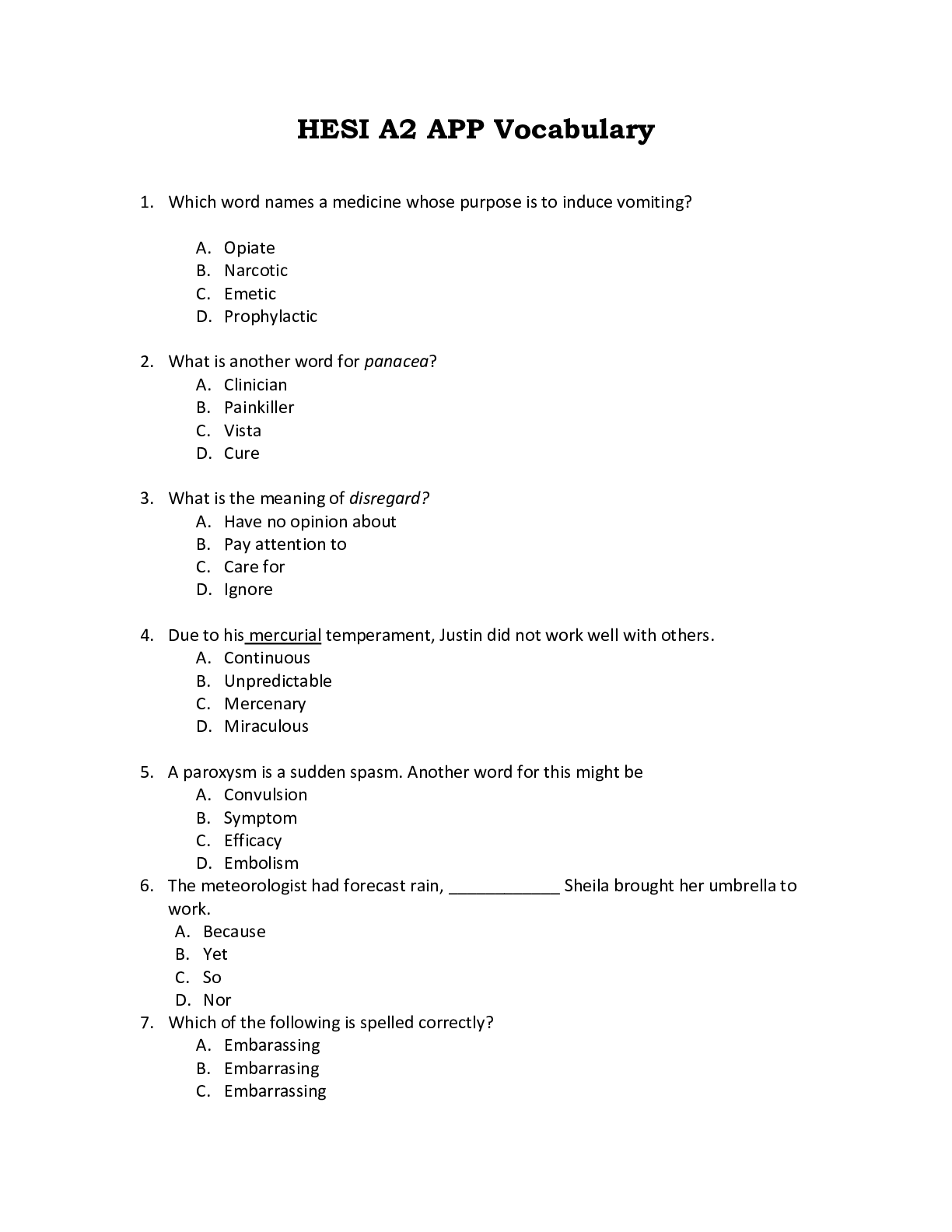
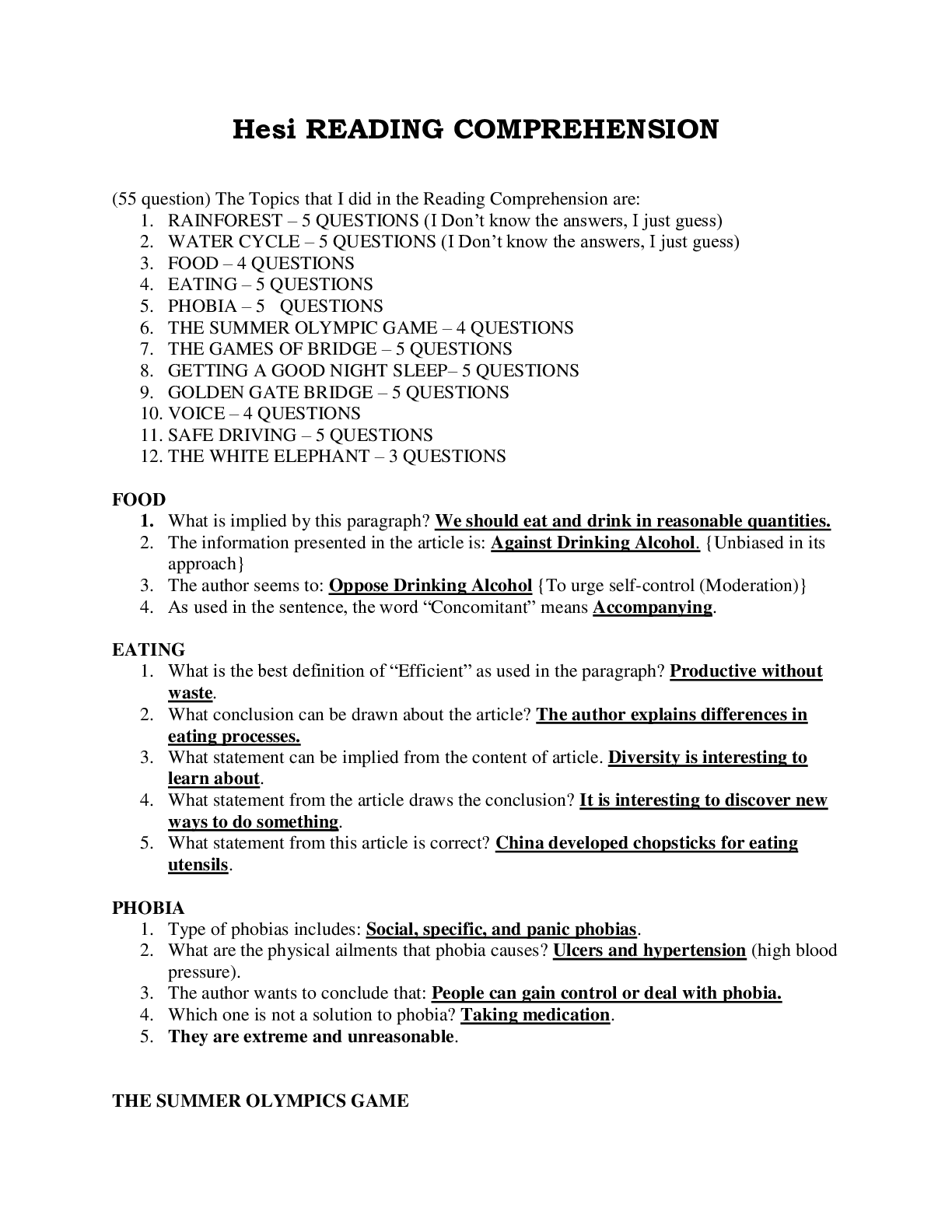
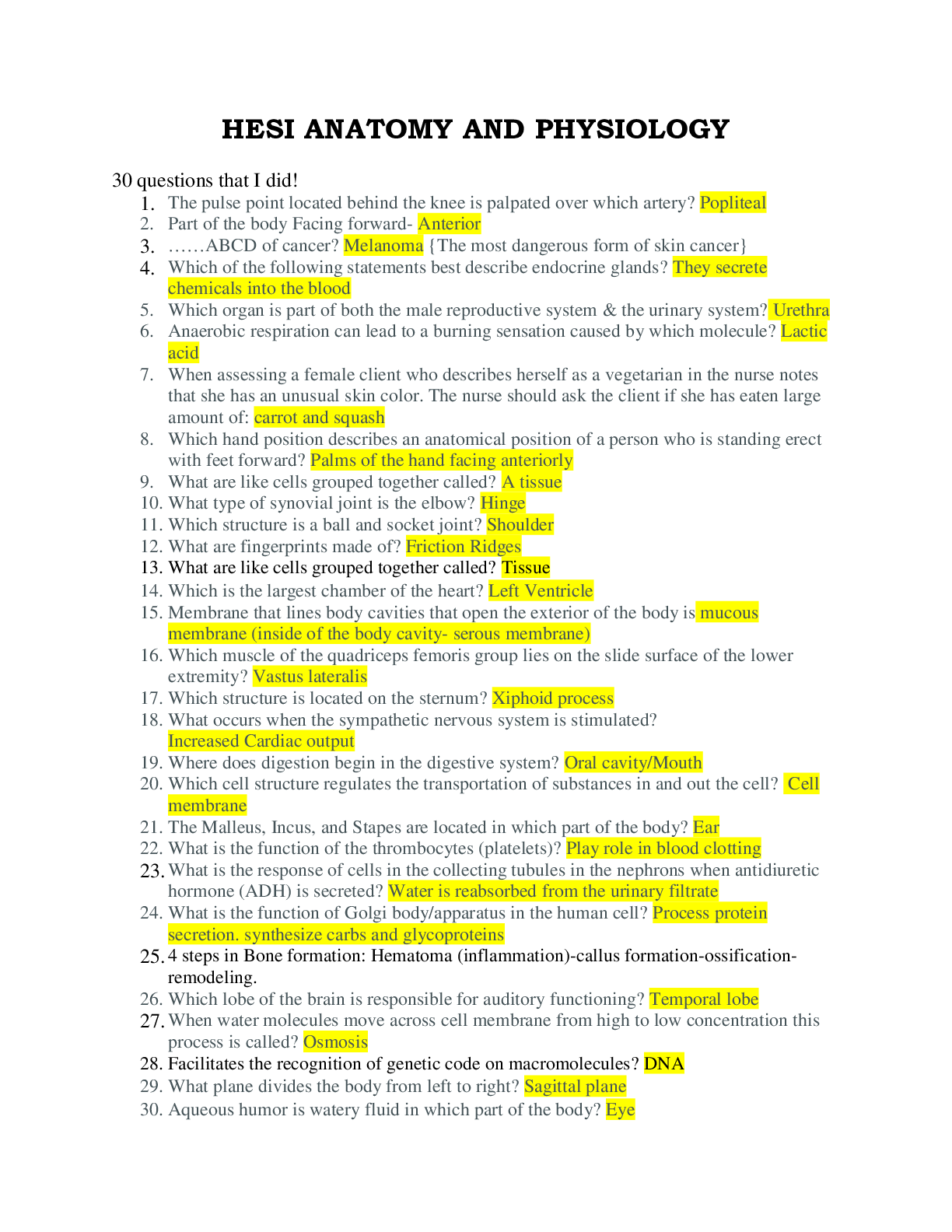
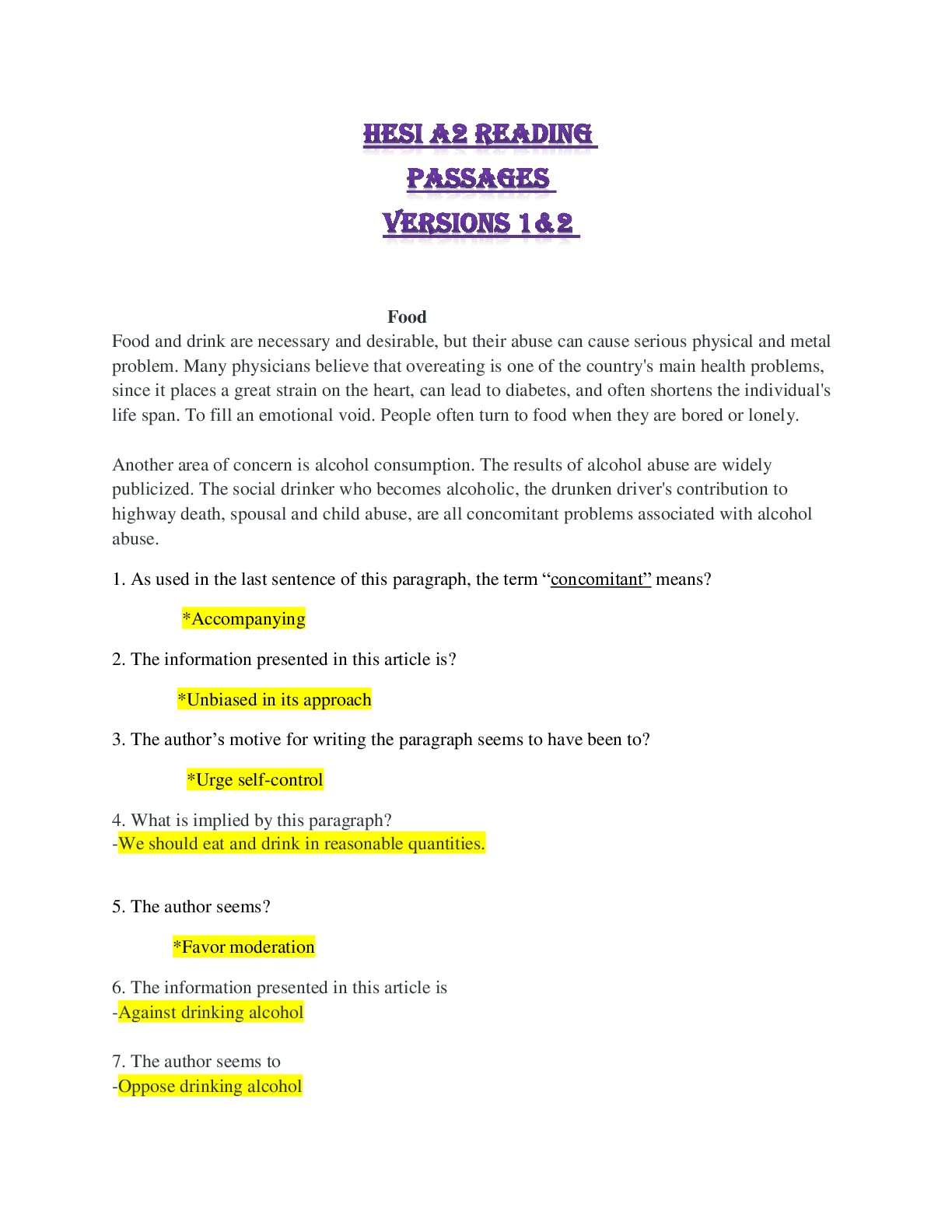
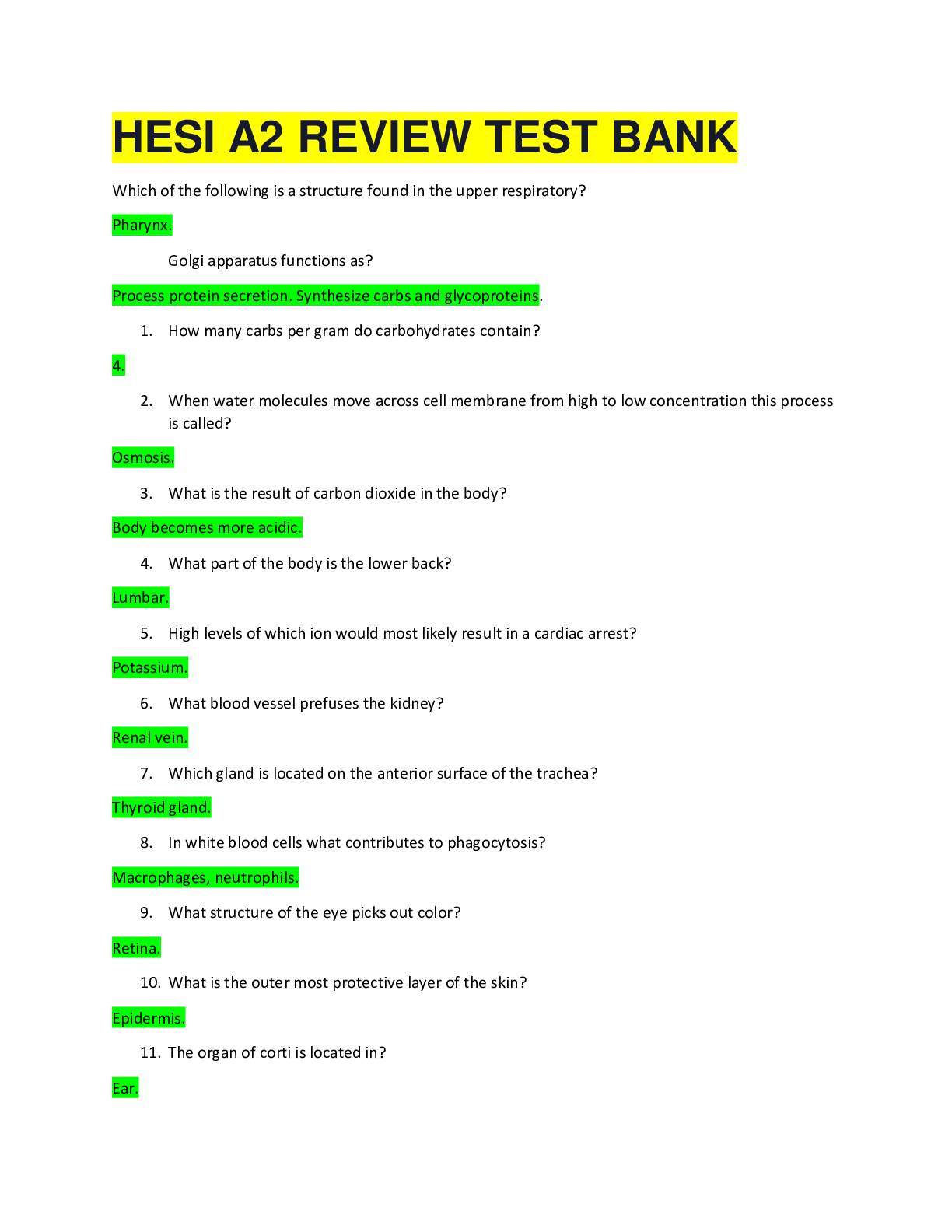
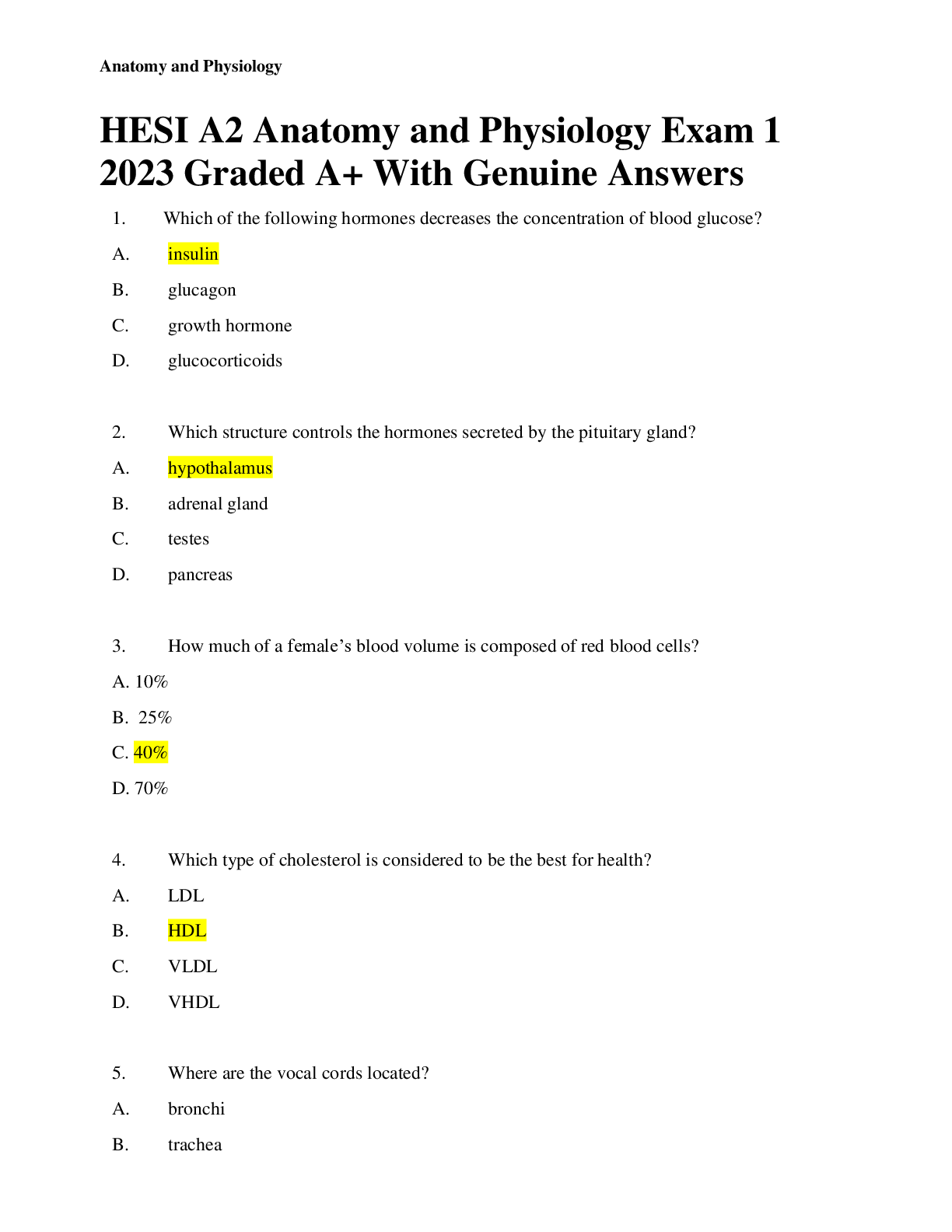
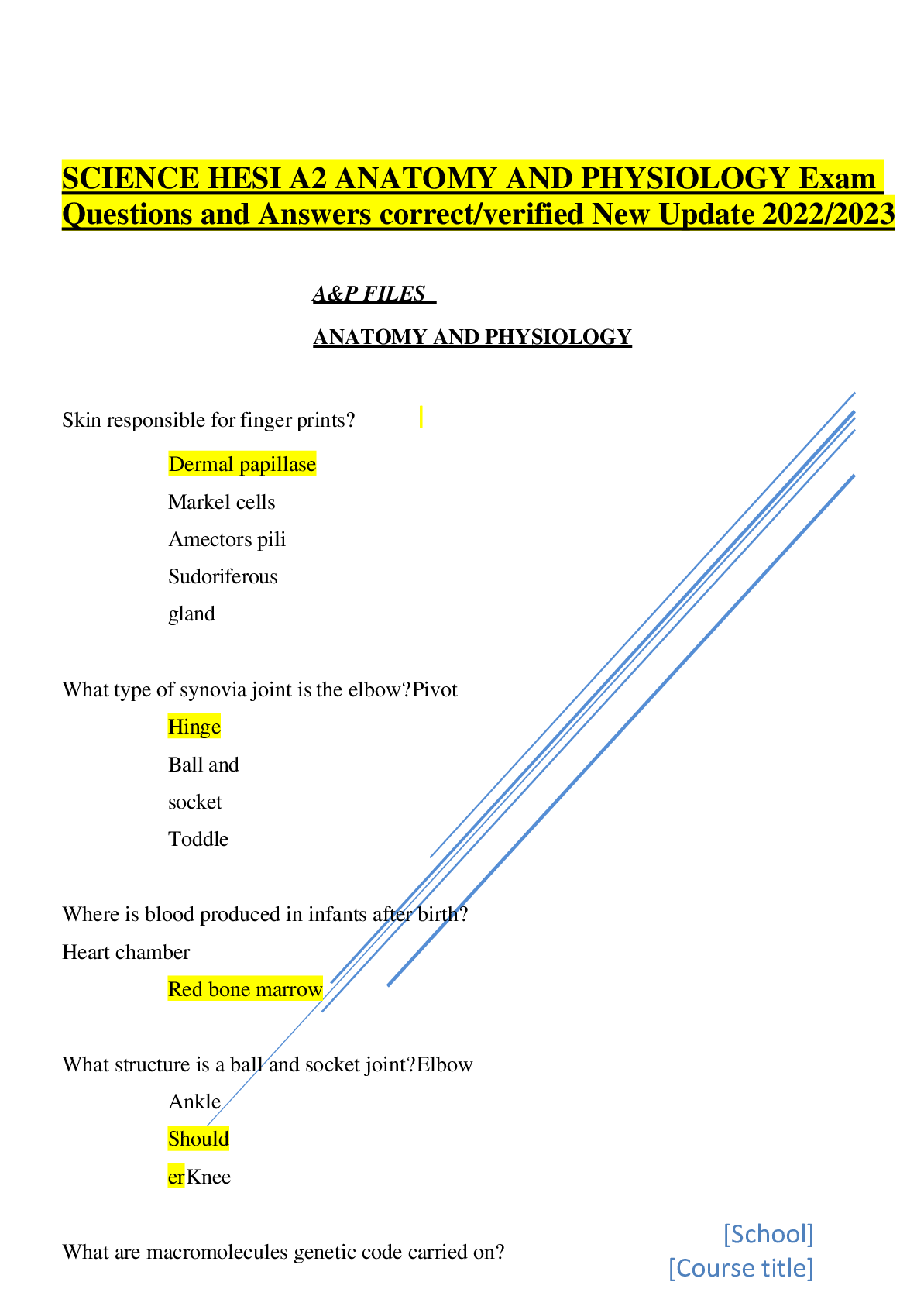
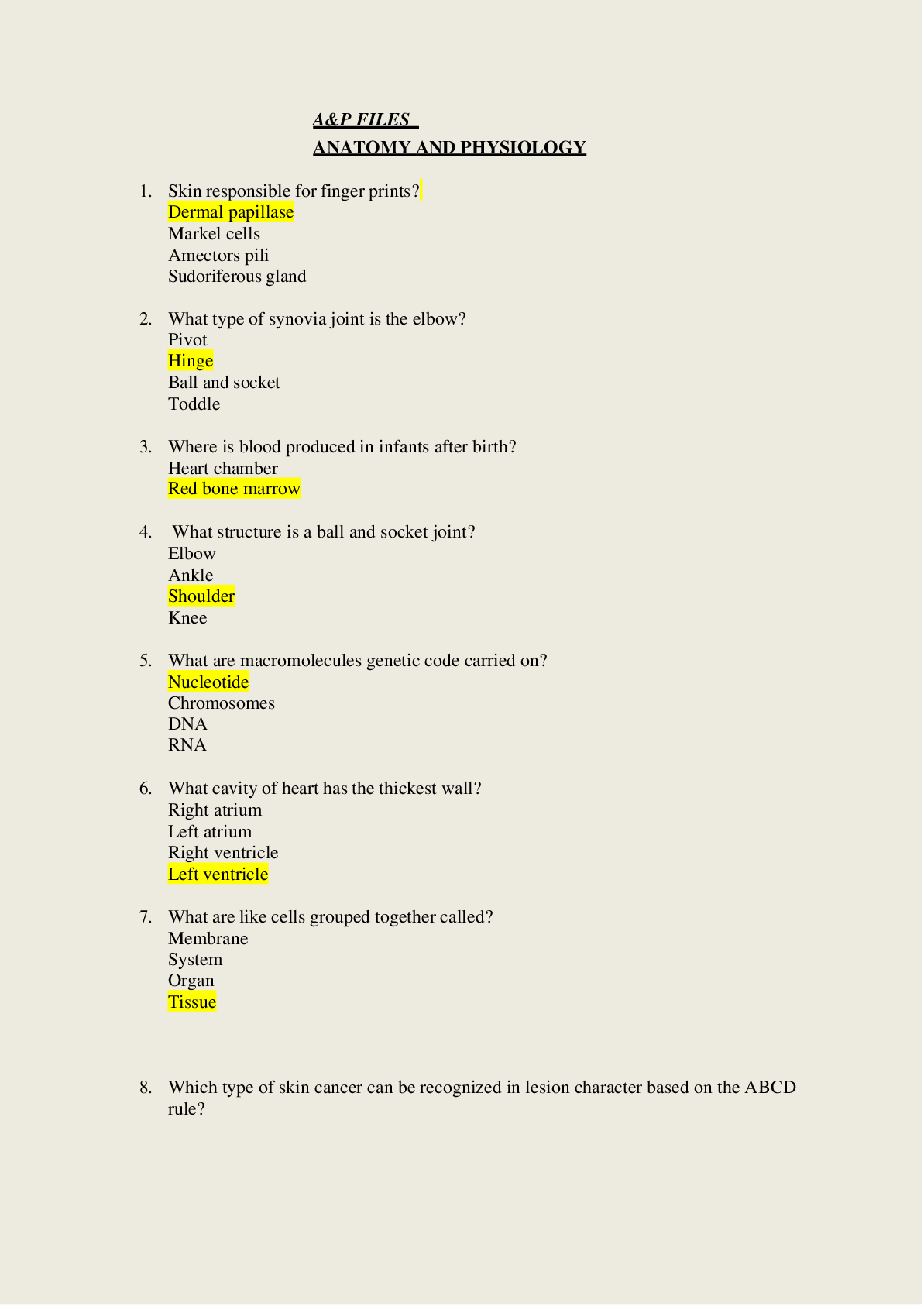
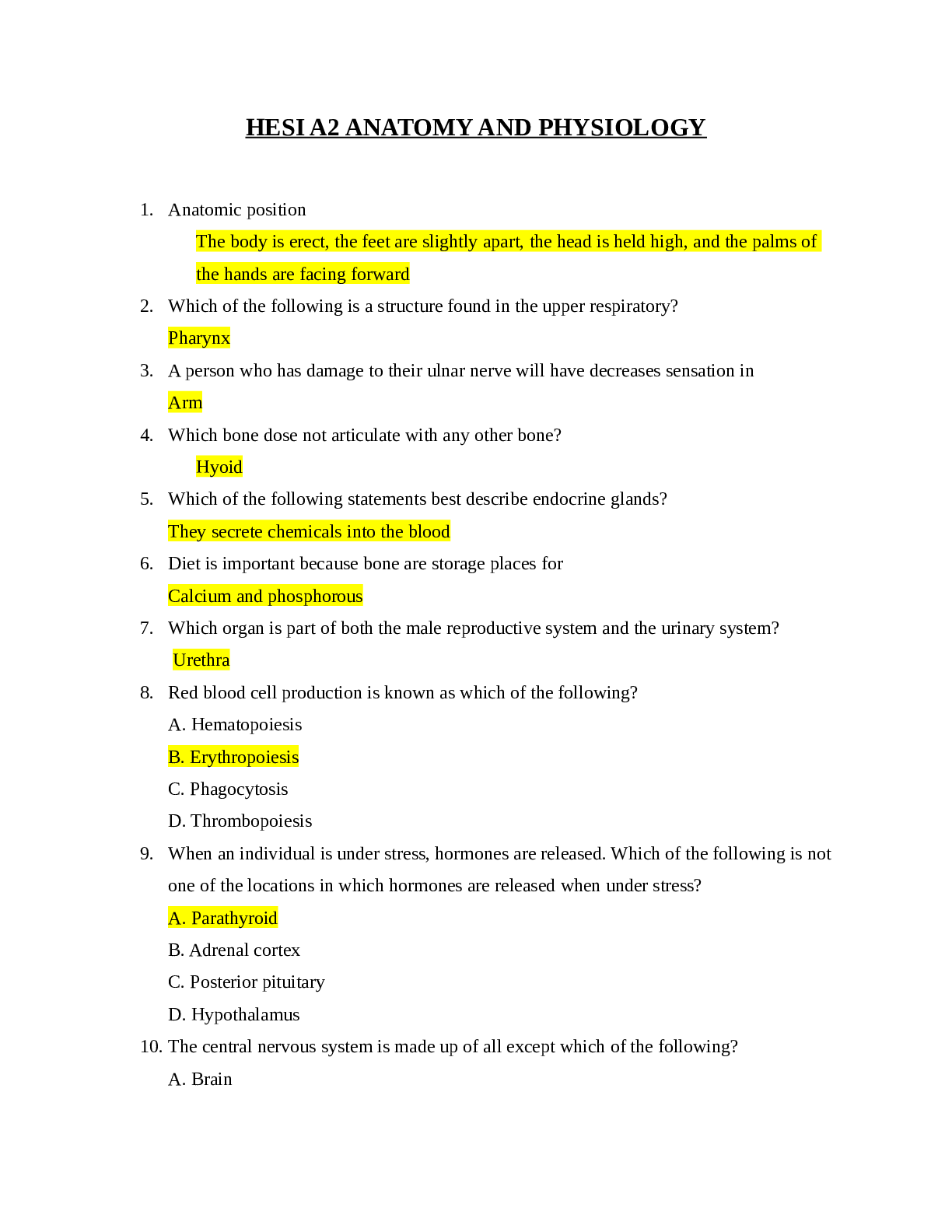
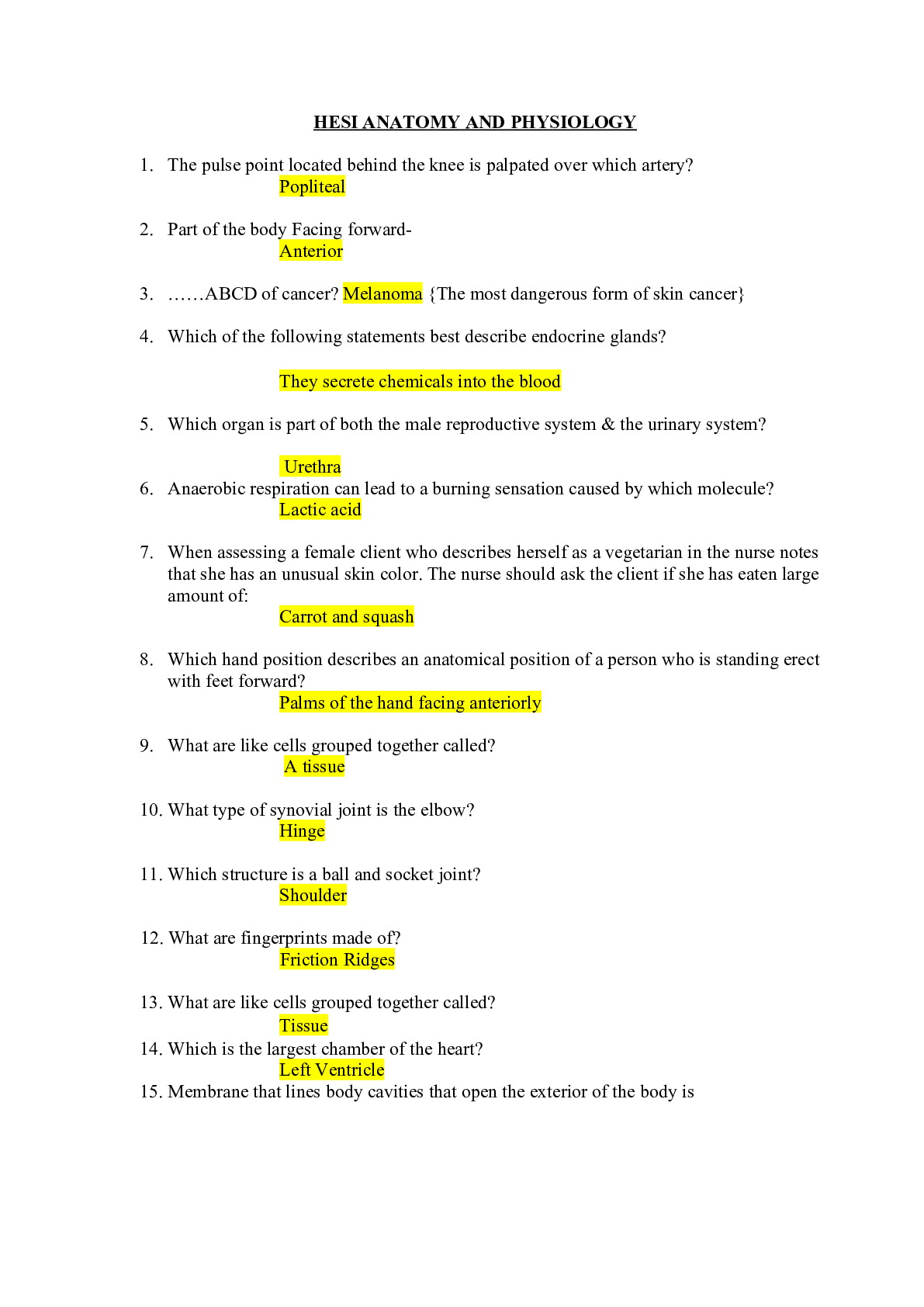
 LATEST QUESTIONS AND COMPLETE SOLUTIONS.png)

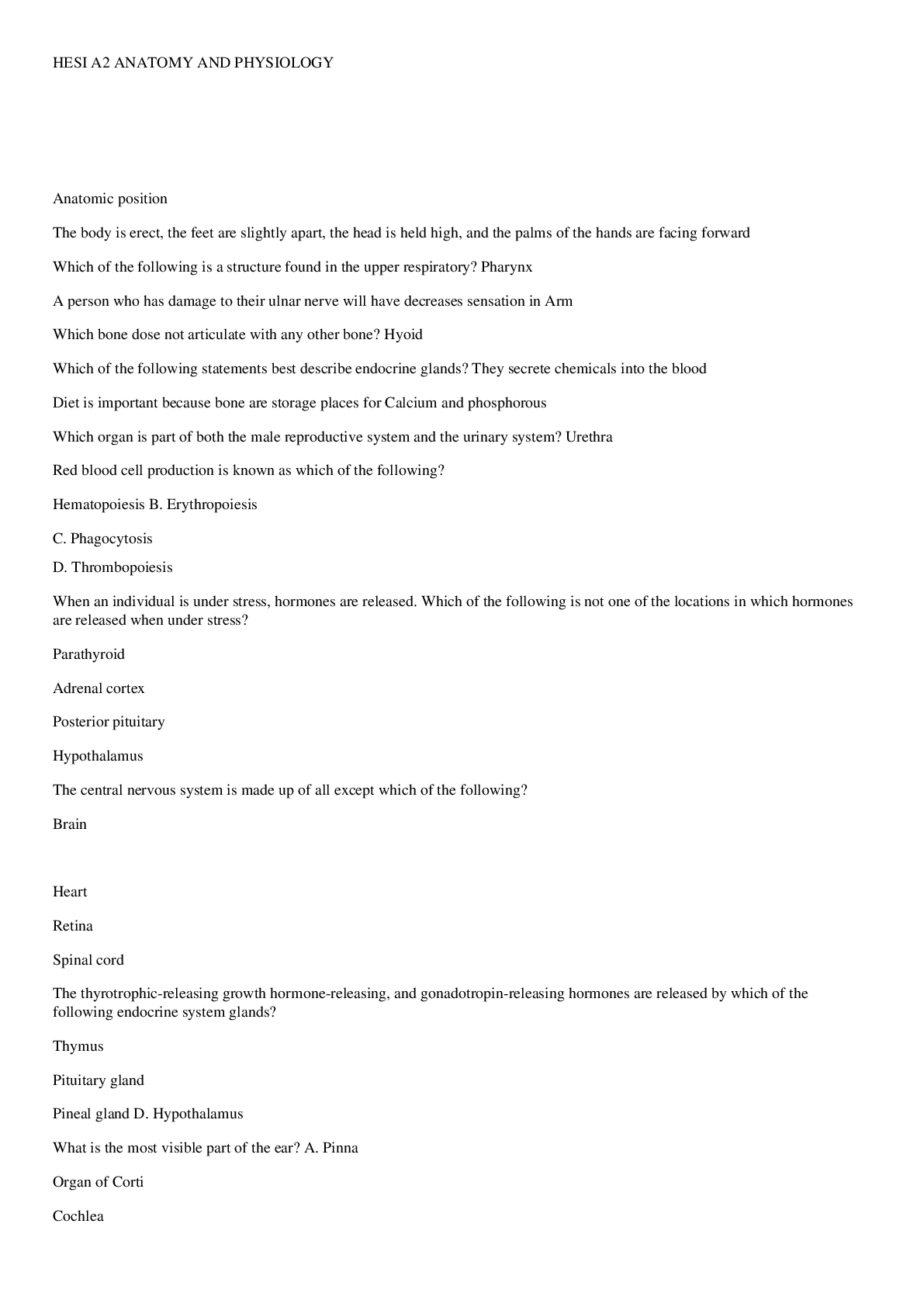
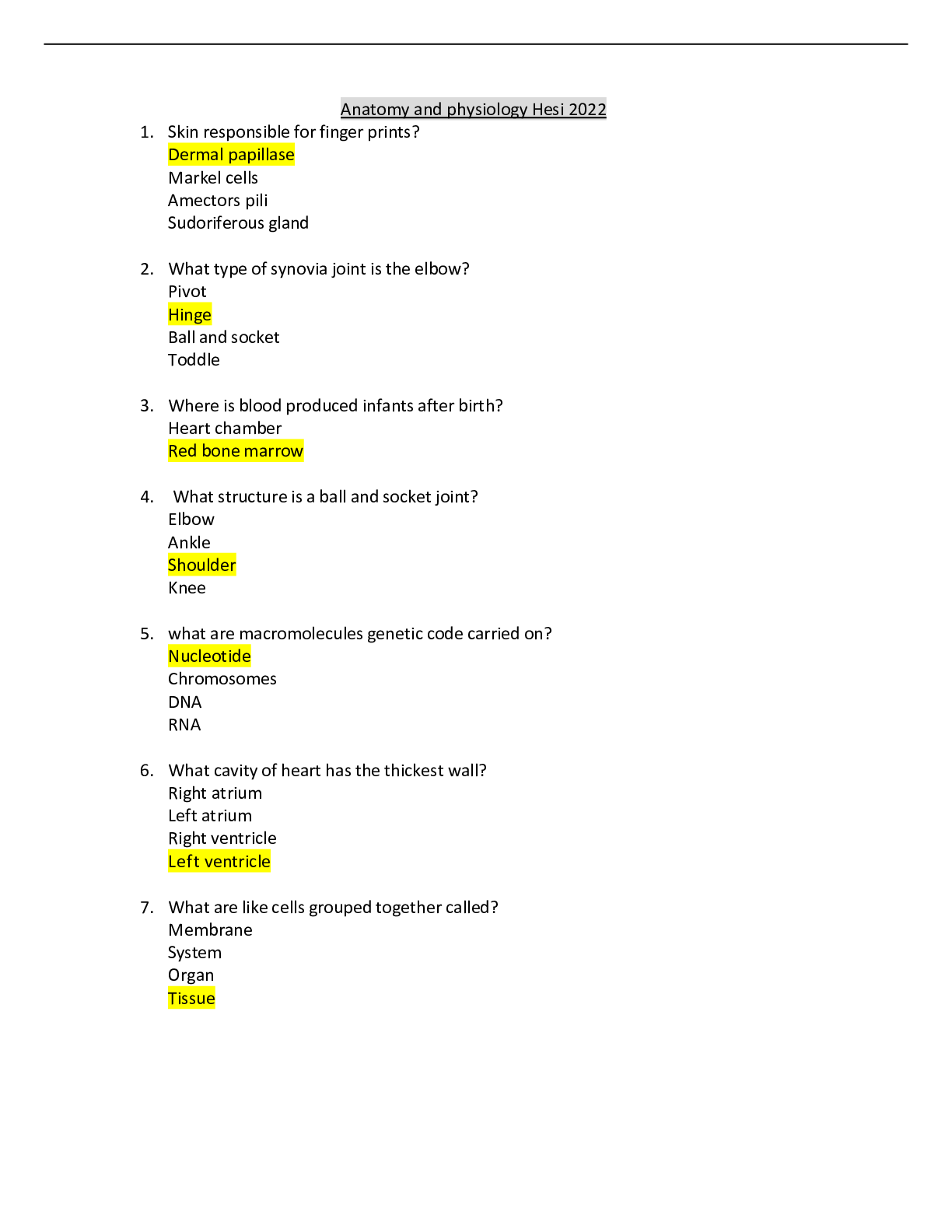
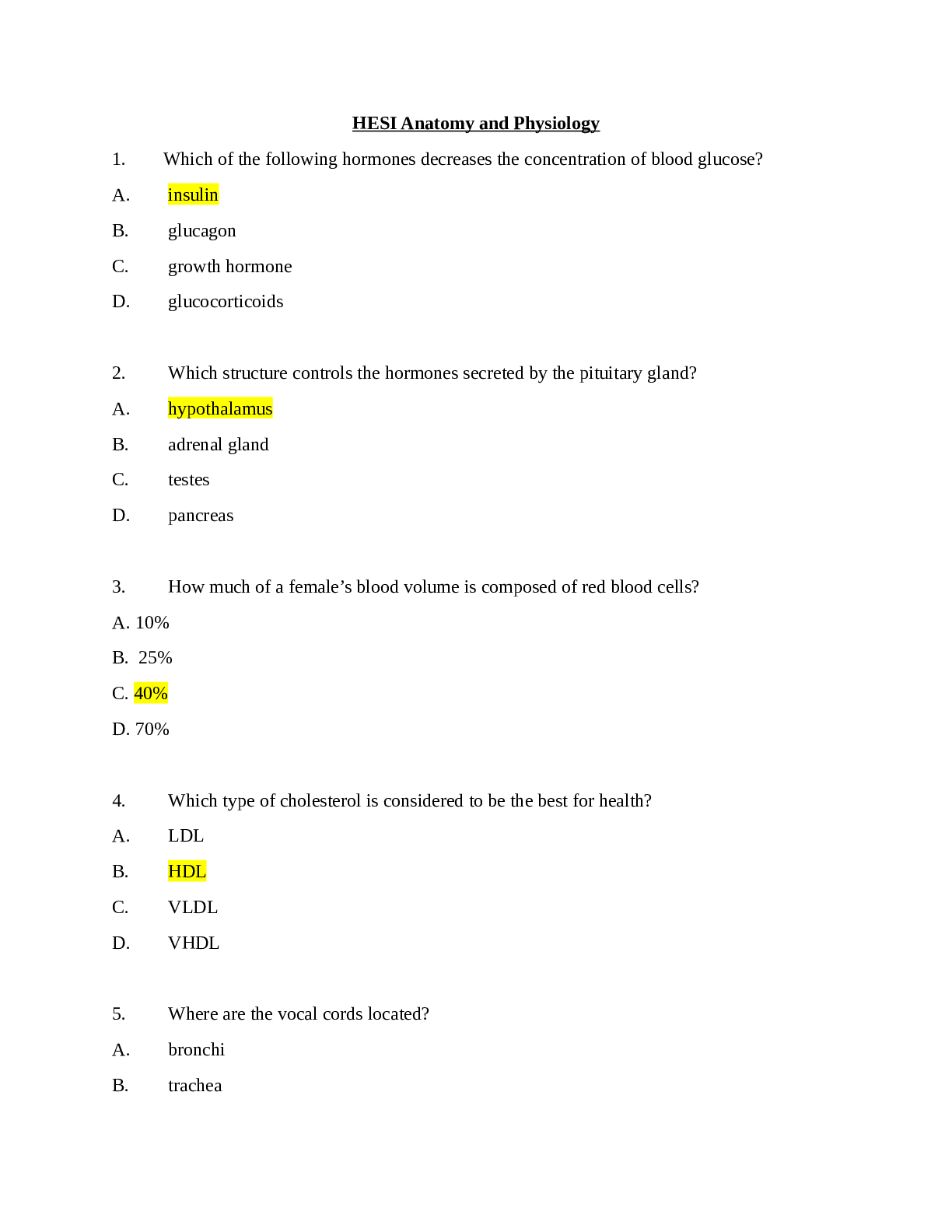
 LATEST GUIDE 2022.png)


.png)
